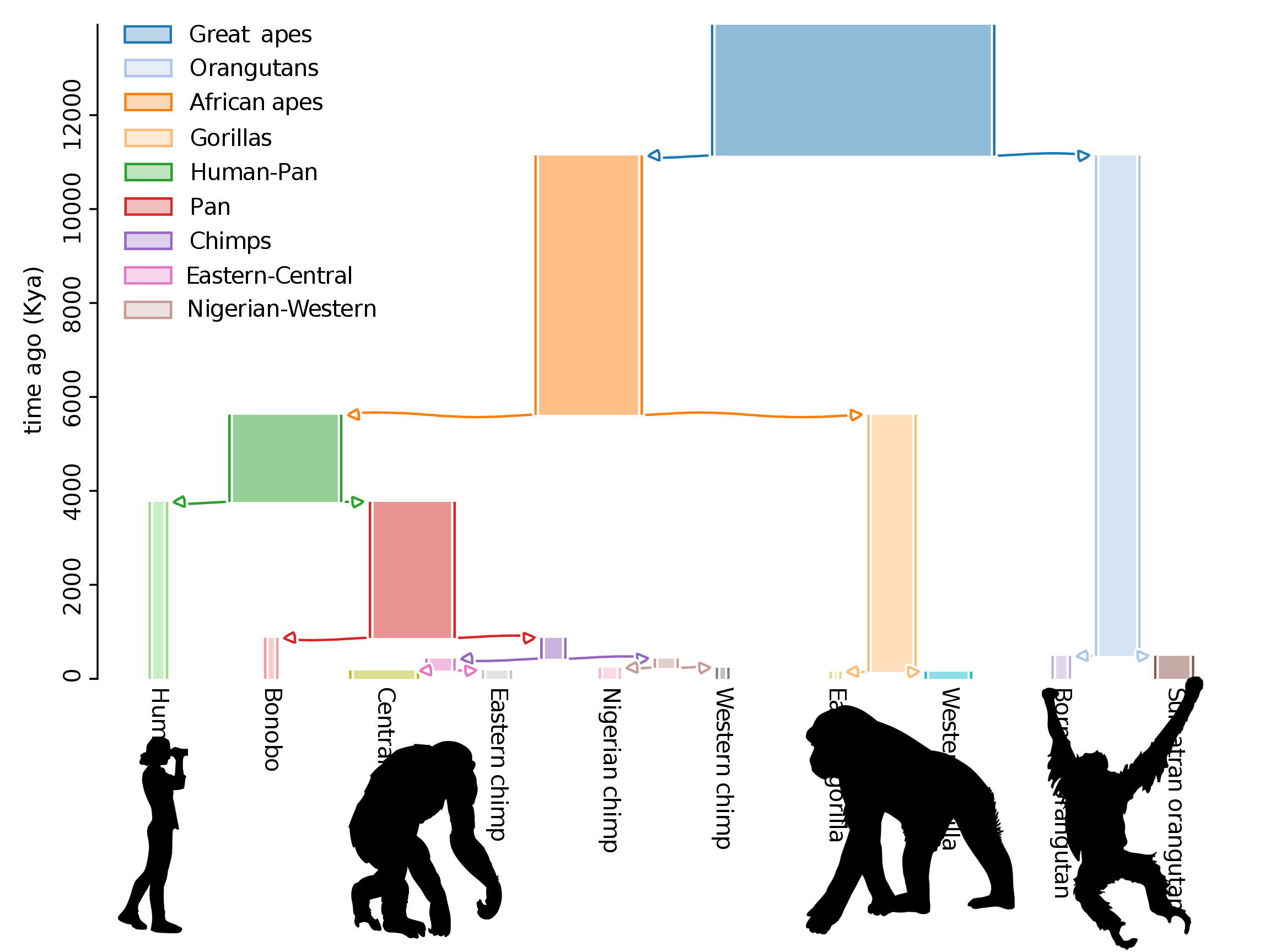Simulation-based inference for ecology and evolution
Peter Ralph // University of Oregon
Ecology, Evolution, and Conservation Biology
Oregon State University // 24 Jan 2024
Both the UO and OSU are located on the traditional indigenous homeland of the Kalapuya people. Kalapuya people were dispossessed of their indigenous homeland by the United States government and forcibly removed. Today, Kalapuya descendants are primarily citizens of the Confederated Tribes of Grand Ronde and the Confederated Tribes of Siletz Indians, and continue to make important contributions to their communities, to the UO, to Oregon, and to the world.
Outline
Outline of the talk
Tree sequences, and simulations
Spatial landscapes of coevolving traits
Landscapes of genetic diversity
Inference, with genomes
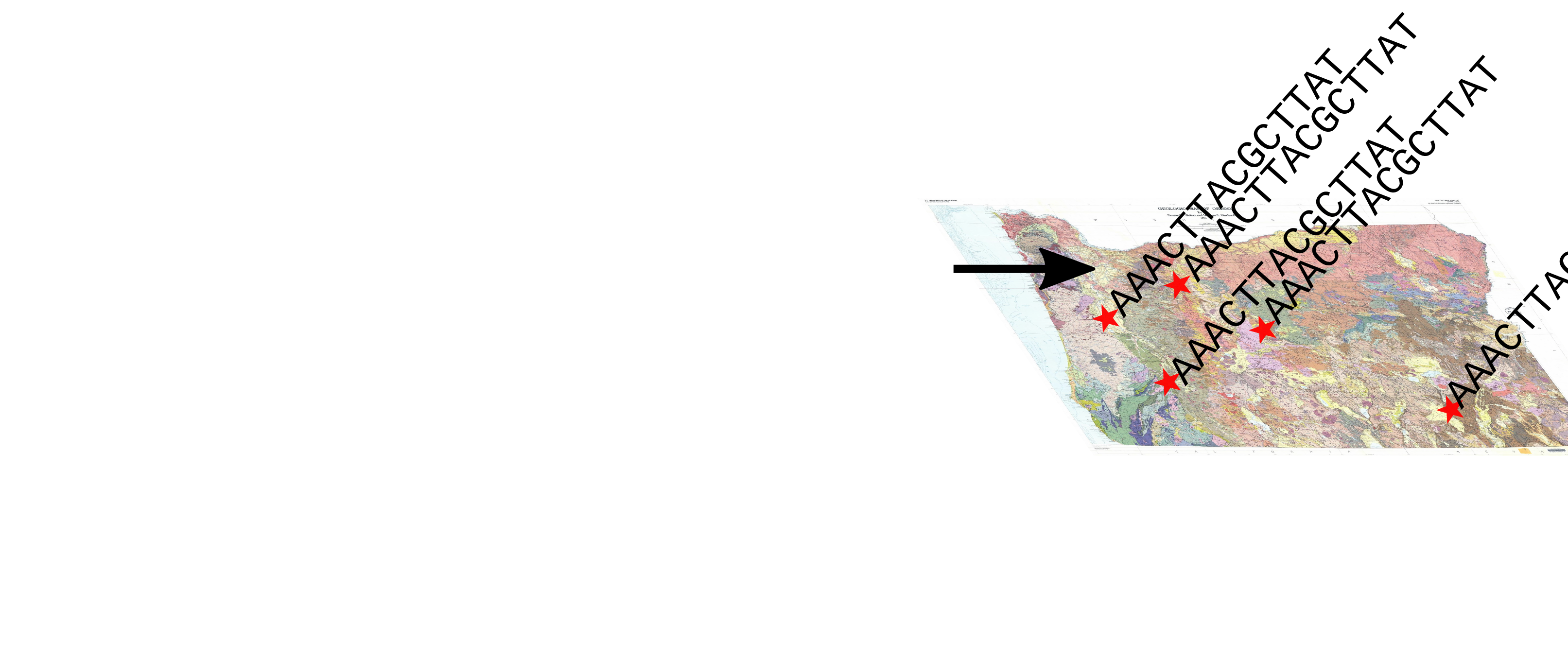
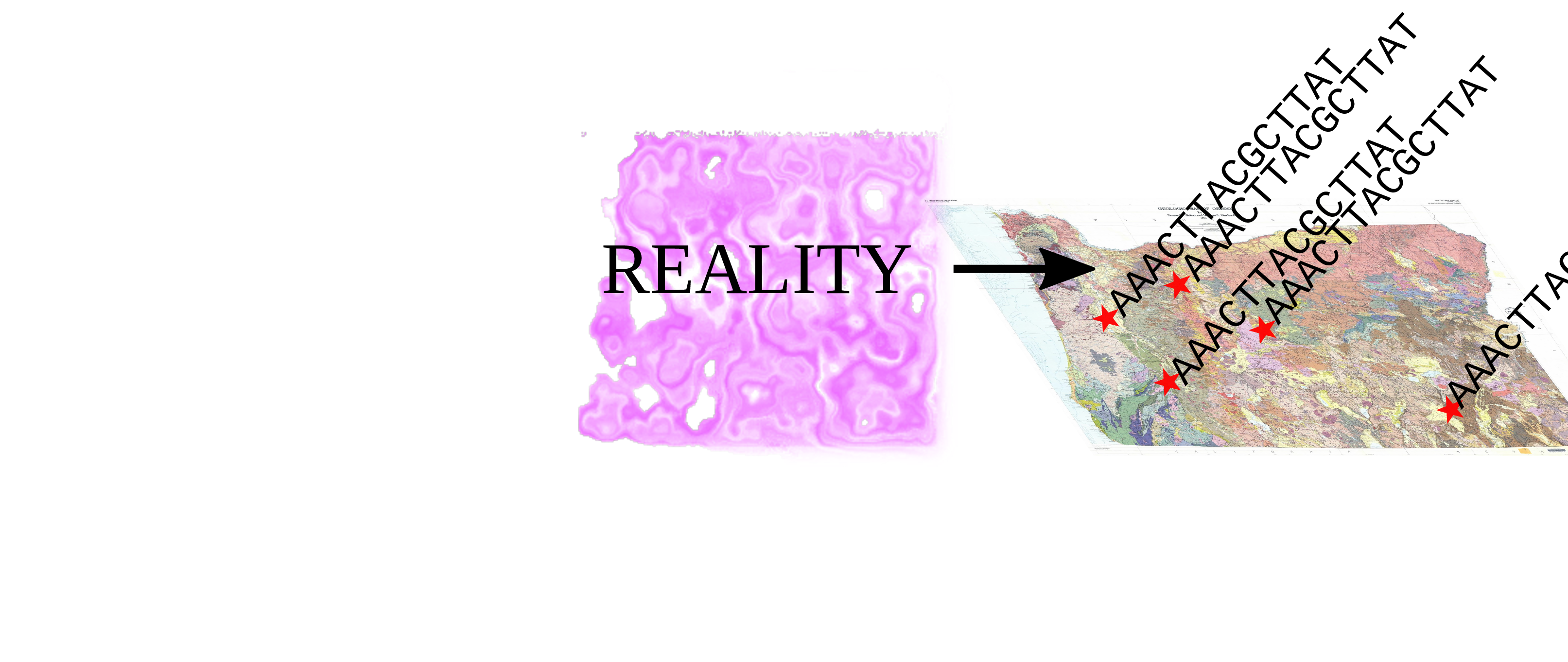
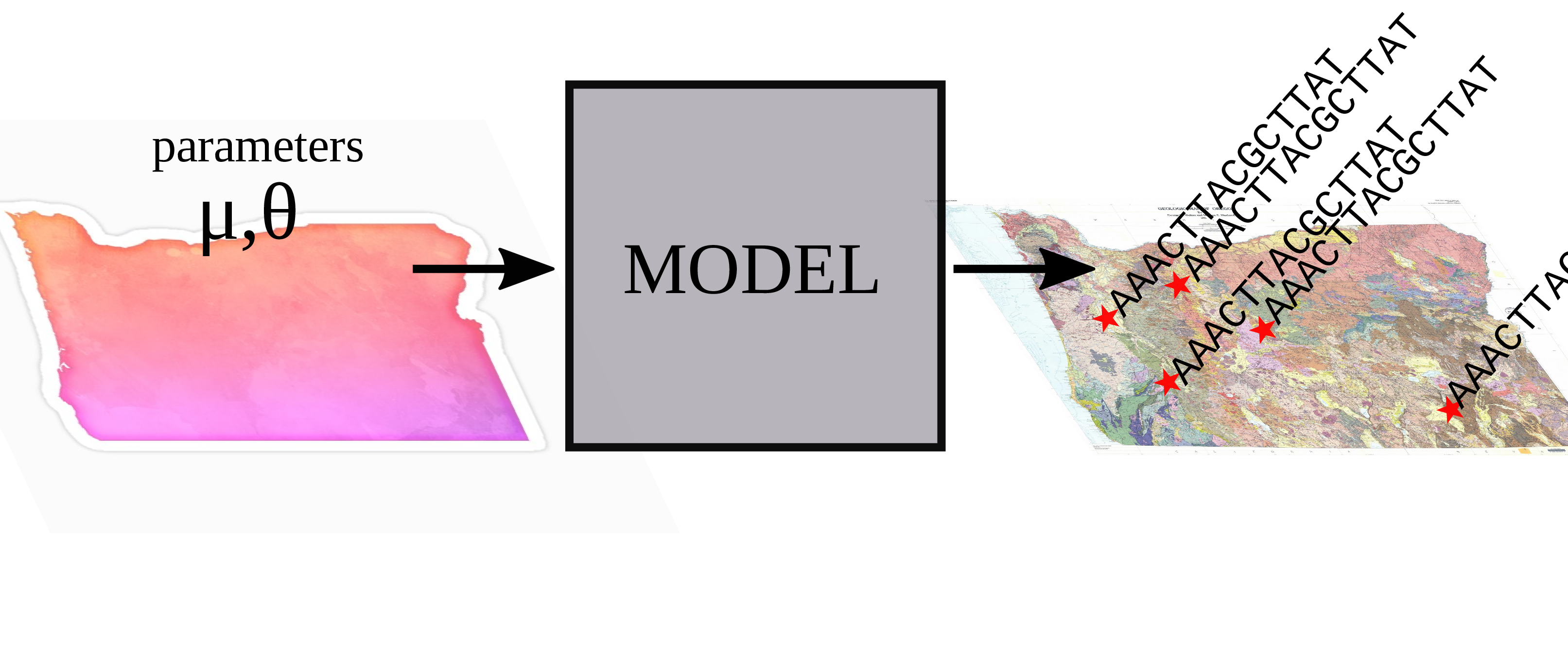
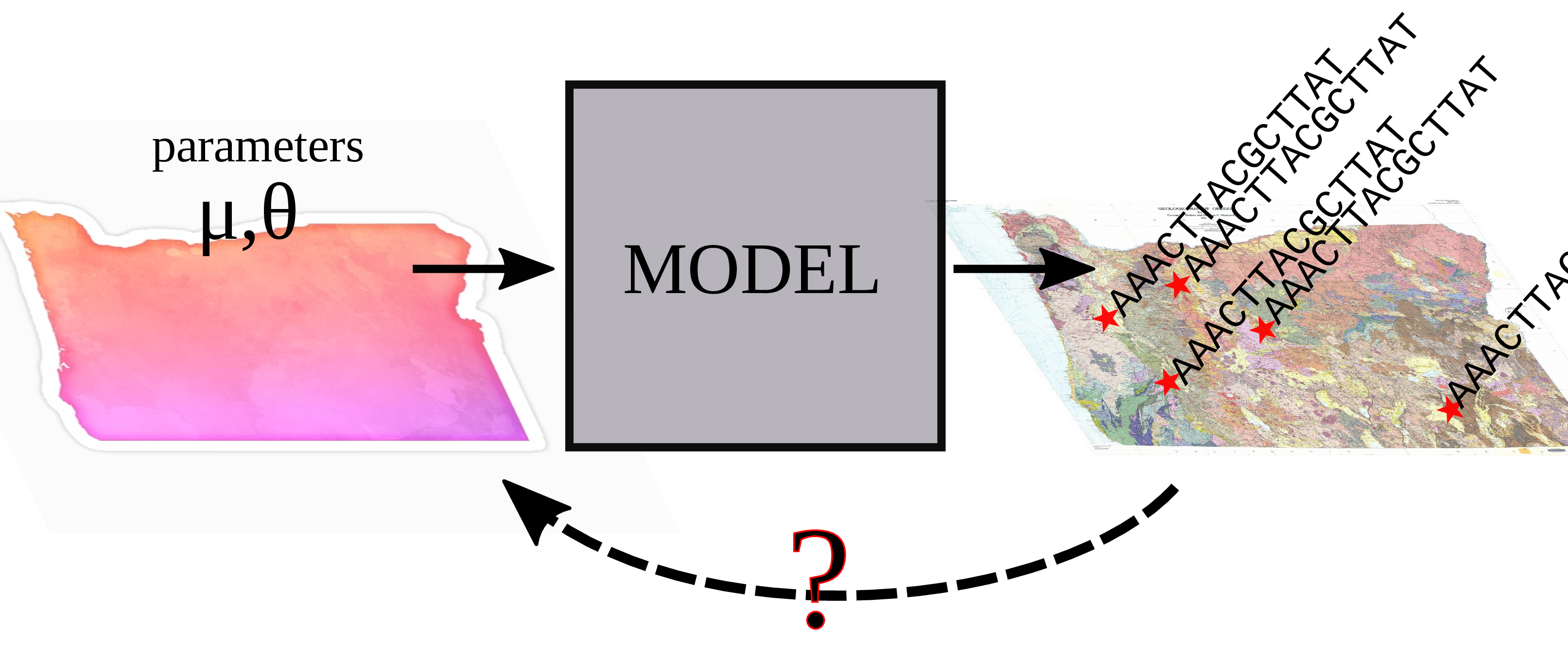
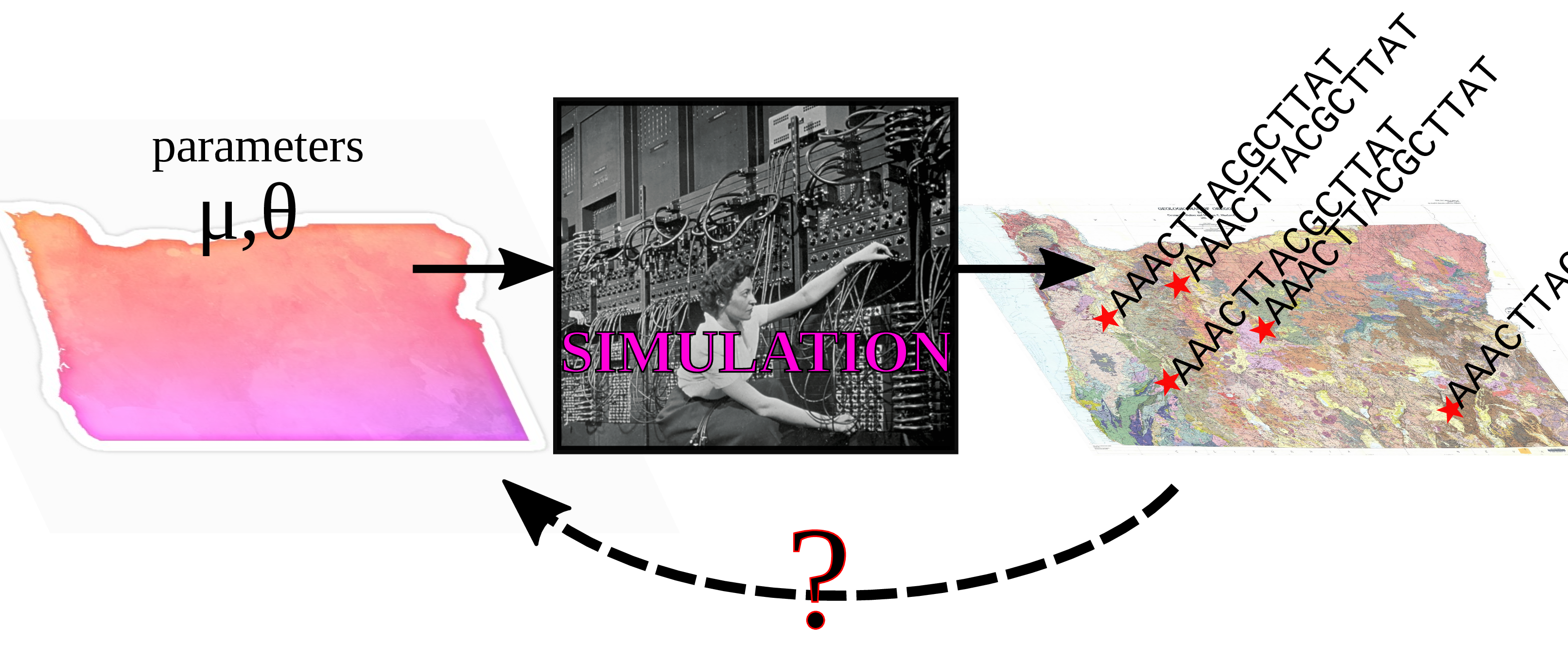
Simulation-based inference

- bespoke confirmatory simulations
- optimization of one or two parameters
- Approximate Bayesian Computation (ABC)
- deep learning
What do we need
Fast simulation of genomes
Fast computation of summary statistics
Wish list:
Whole genomes, thousands of samples,
from millions of individuals.
Demography:
- life history
- separate sexes
- selfing
- polyploidy
- species interactions
Geography:
- discrete populations
- continuous landscapes
- barriers
History:
- ancient samples
- range shifts
Natural selection:
- selective sweeps
- introgressing alleles
- background selection
- quantitative traits
- incompatibilities
- local adaptation
Genomes:
- recombination rate variation
- gene conversion
- infinite-sites mutation
- nucleotide models
- context-dependence
- mobile elements
- inversions
- copy number variation
Enter SLiM
by Ben Haller and Philipp Messer
an individual-based, scriptable forwards simulator
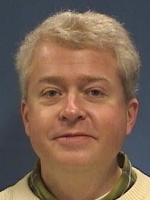

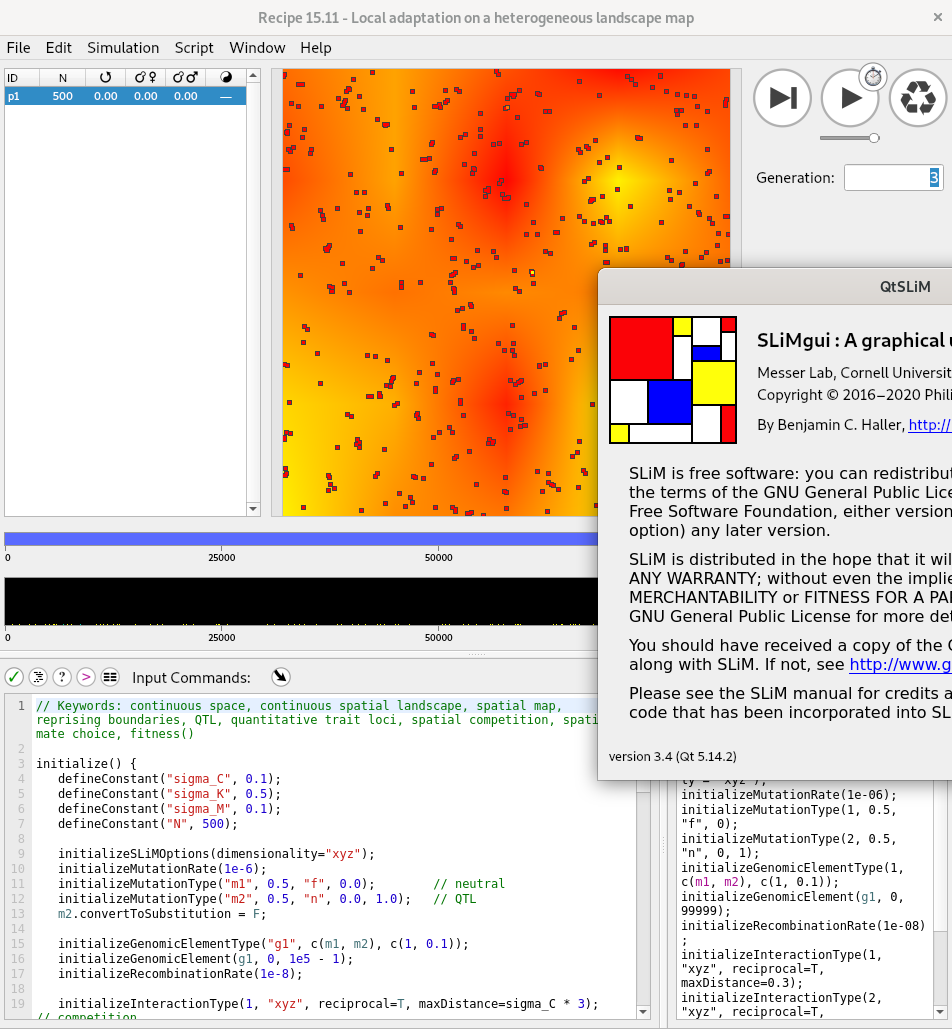
Whole genomes,*thousands of samples,from millions of individuals.*
Demography:
life historyseparate sexes*selfing- polyploidy*
species interactions
Geography:
discrete populationscontinuous landscapesbarriers*
History:
ancient samplesrange shifts
Natural selection:
selective sweepsintrogressing allelesbackground selectionquantitative traits*incompatibilities*local adaptation*
Genomes:
recombination rate variationgene conversioninfinite-sites mutationnucleotide modelscontext-dependence*- mobile elements*
- inversions*
- copy number variation
The tree sequence
History is a sequence of trees
For a set of sampled chromosomes, at each position along the genome there is a genealogical tree that says how they are related.
The succinct tree sequence
is a way to succinctly describe this, er, sequence of trees
and the resulting genome sequences.


jerome kelleher
How’s it work? File sizes:
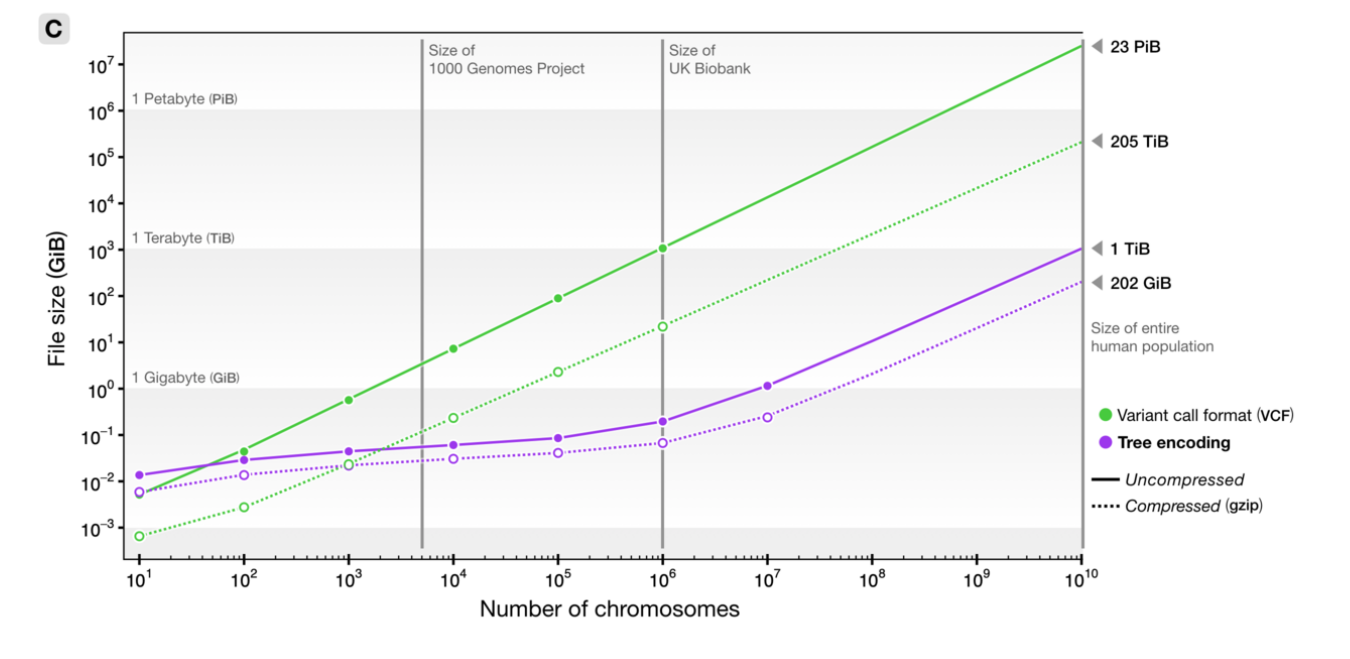
100Mb chromosomes; from Kelleher et al 2018, Inferring whole-genome histories in large population datasets, Nature Genetics


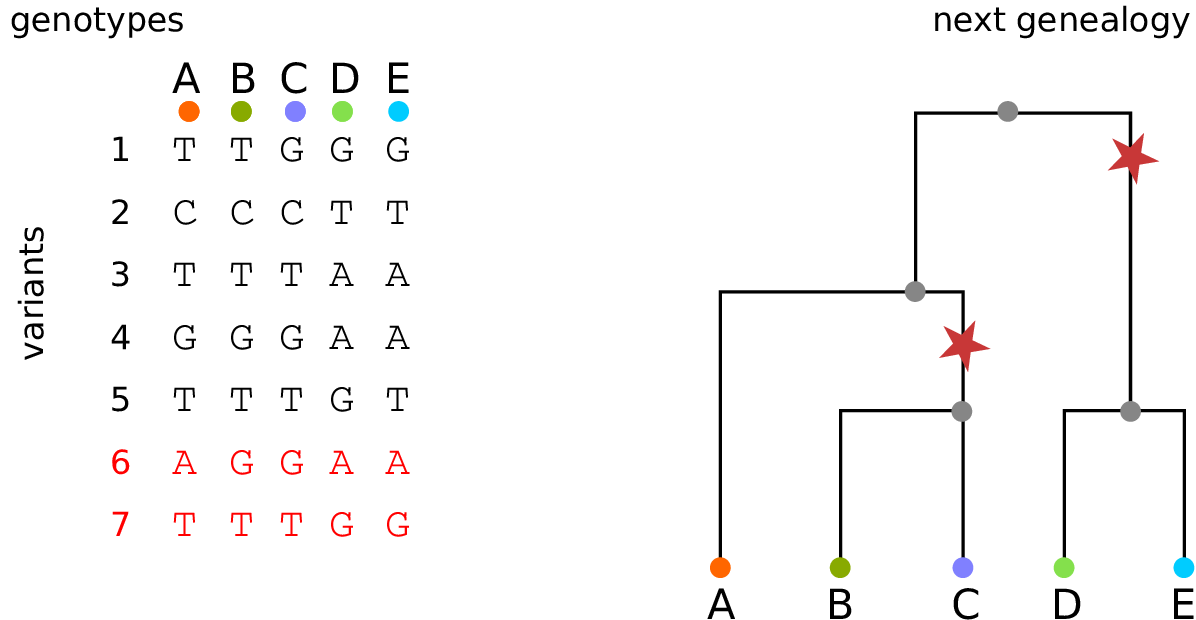
For \(N\) samples genotyped at \(M\) sites
Genotype matrix:
\(N \times M\) things.
Tree sequence:
- \(2N-2\) edges for the first tree
- \(\sim 4\) edges per each of \(T\) trees
- \(M\) mutations
\(O(N + T + M)\) things

How’s it work, 2? Computation time:
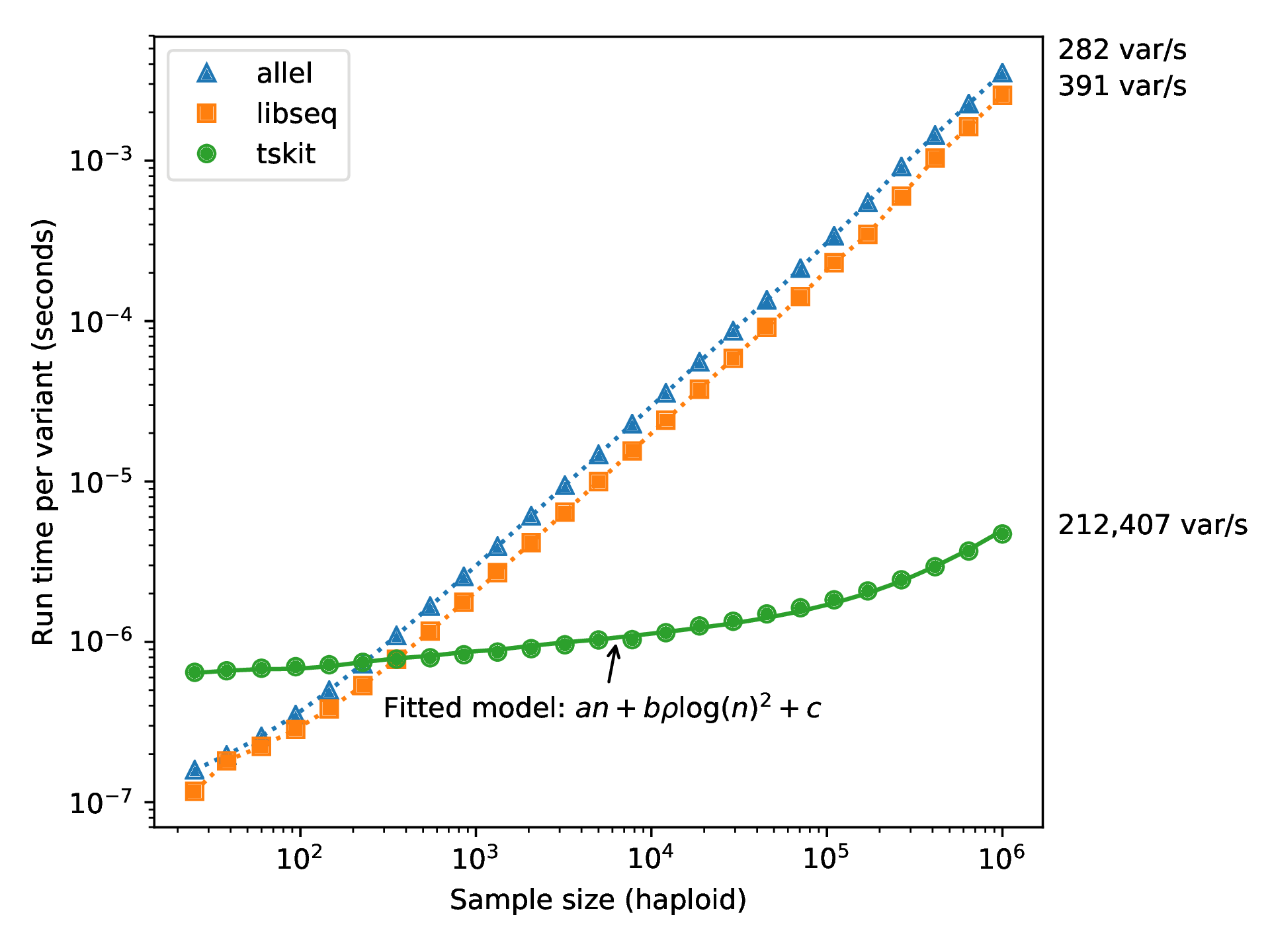
Application to genomic simulations
The main idea
Genomes are very big.
But, if we record the tree sequence that relates everyone to everyone else,
after the simulation is over we can put neutral mutations down on the trees.
Since neutral mutations don’t affect demography,
this is equivalent to having kept track of them throughout.
This means recording the entire genetic history of everyone in the population, ever.
It is not clear this is a good idea.
But, with a few tricks…
From Kelleher, Thornton, Ashander, and R. 2018, Efficient pedigree recording for fast population genetics simulation.
and Haller, Galloway, Kelleher, Messer, and R. 2018, Tree‐sequence recording in SLiM opens new horizons for forward‐time simulation of whole genomes

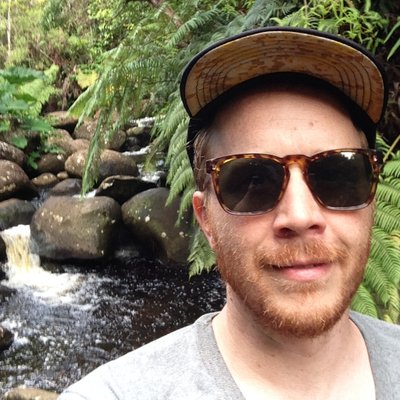

A 100x speedup!
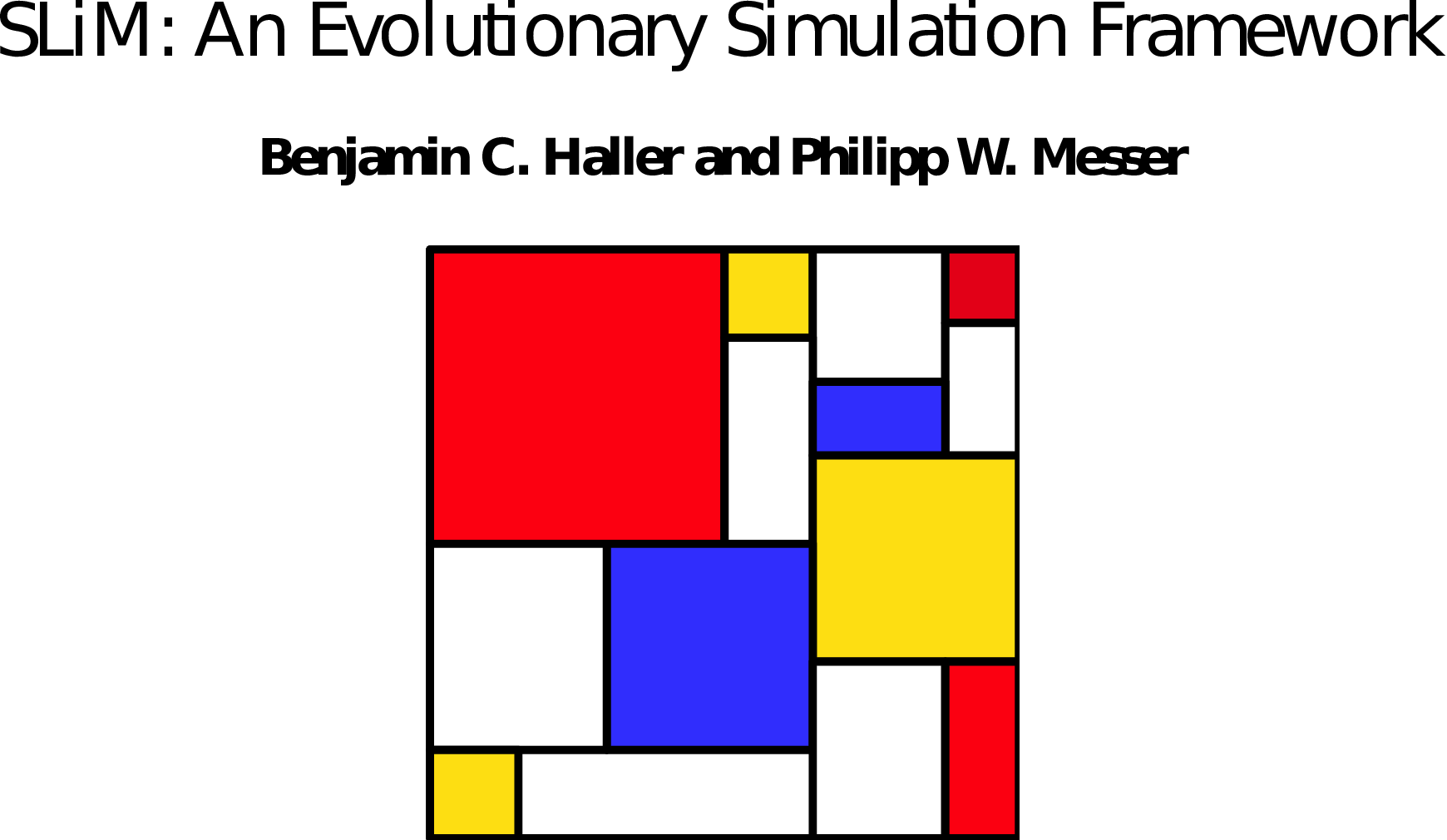
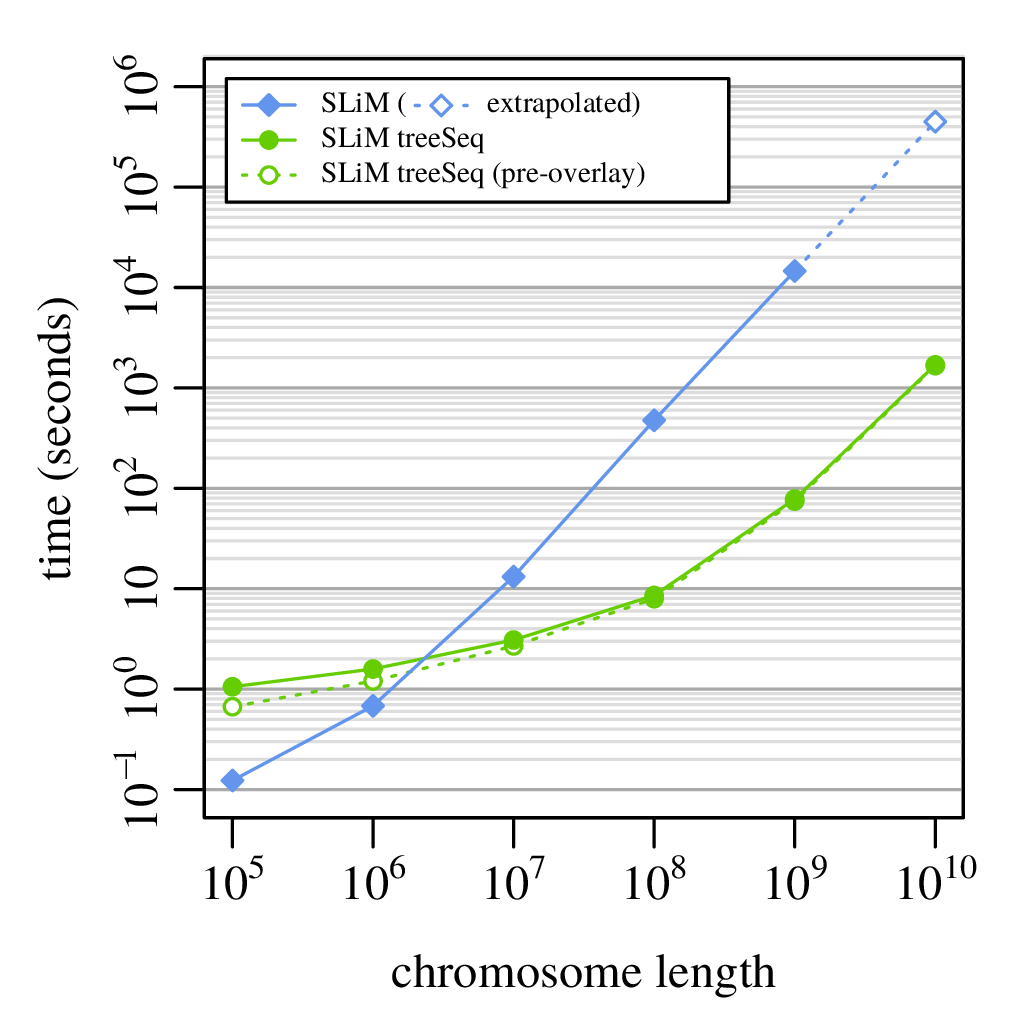
Spatial coevolution: snakes and newts


Victoria Caudill
Image from evolution.berkeley.edu
newt: CC by Steve Jurvetson
snake: CC by Jaden Clark
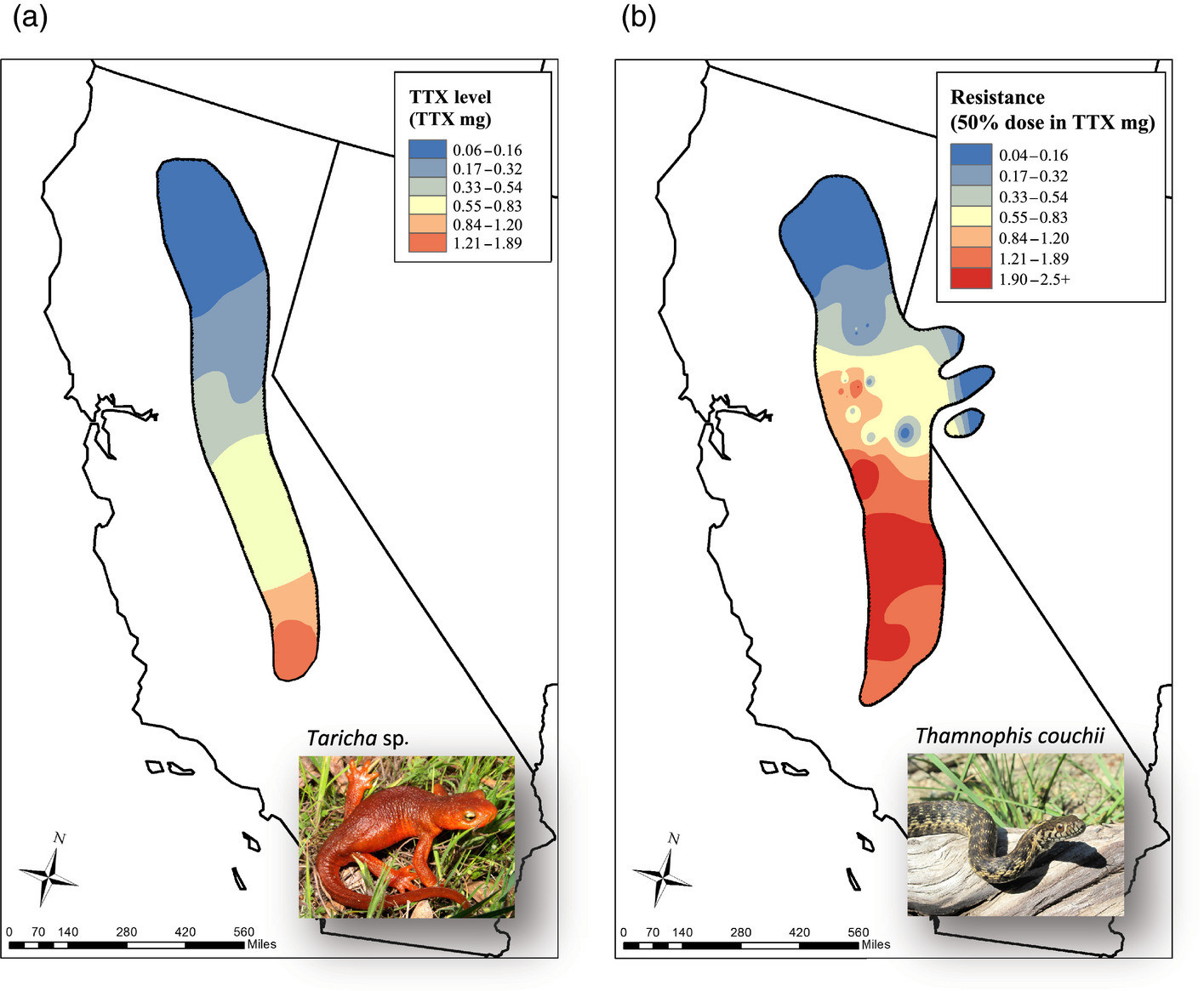
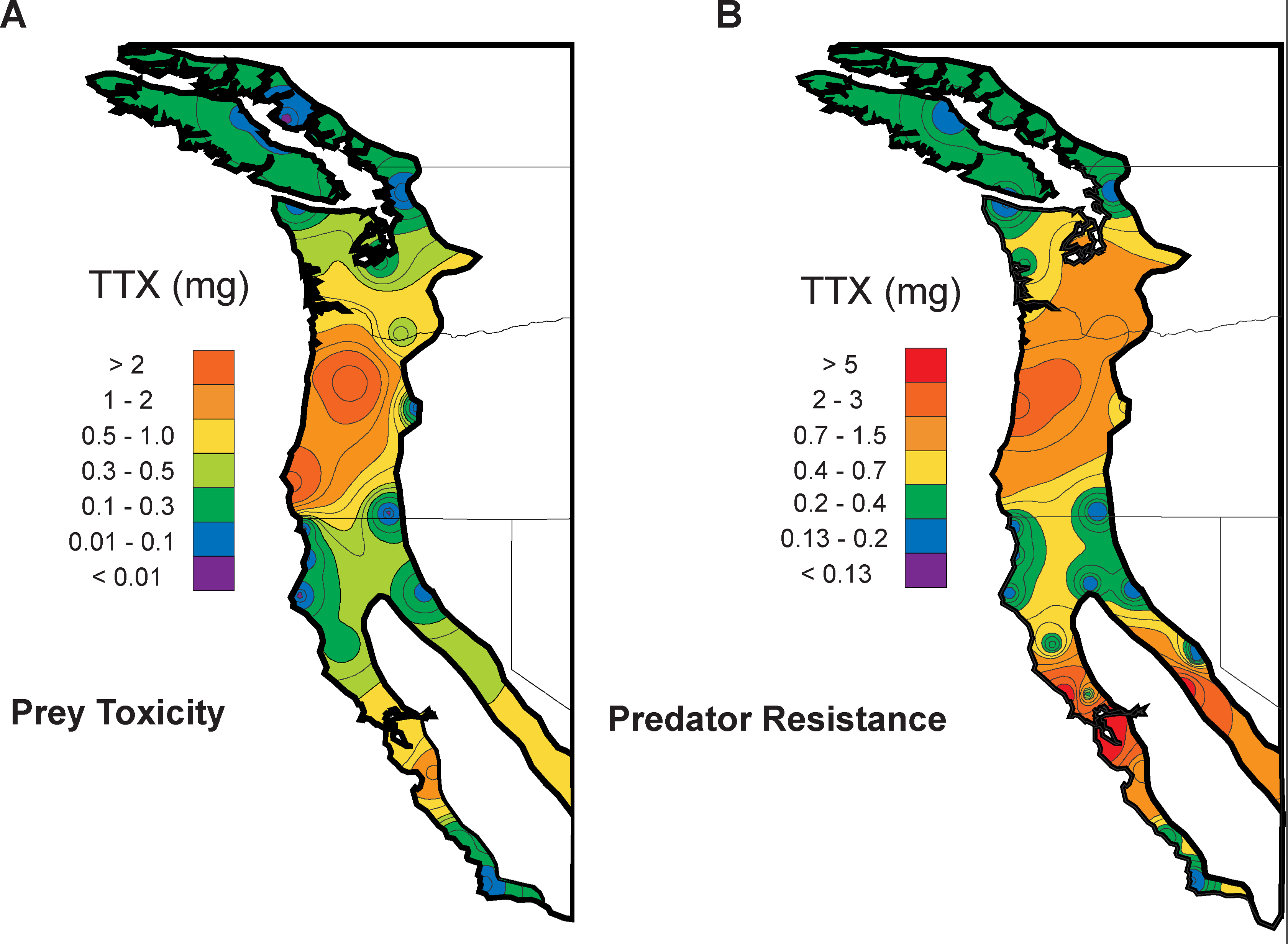
Why, and how?
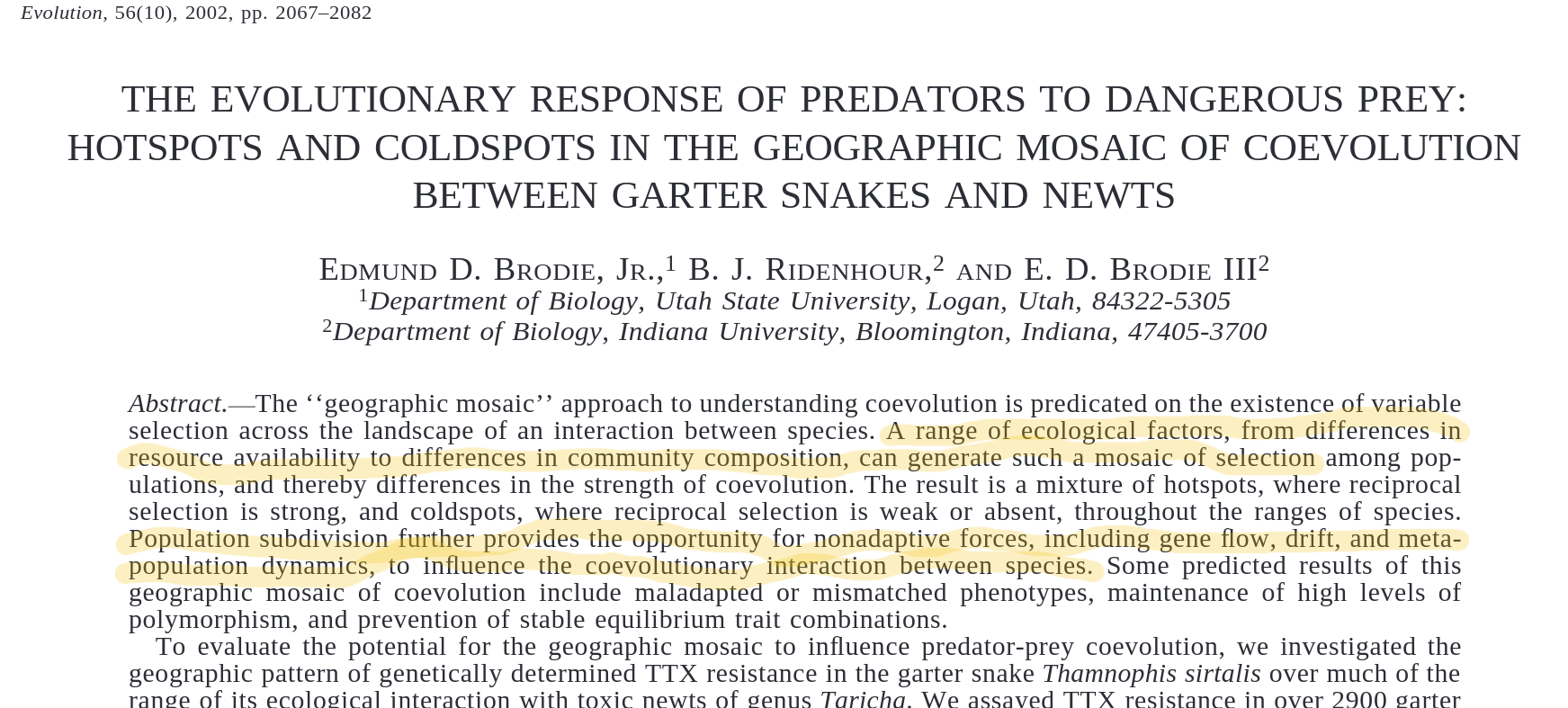
A spatial co-evolutionary simulation
continuous space
local density-dependent mortality
additive, costly traits (“toxicity” and “resistance”)
various genetic architectures
snakes may encounter nearby newts, outcome depends on difference in traits:
- snake eats newt, gets fitness benefit, or
- snake dies, newt escapes
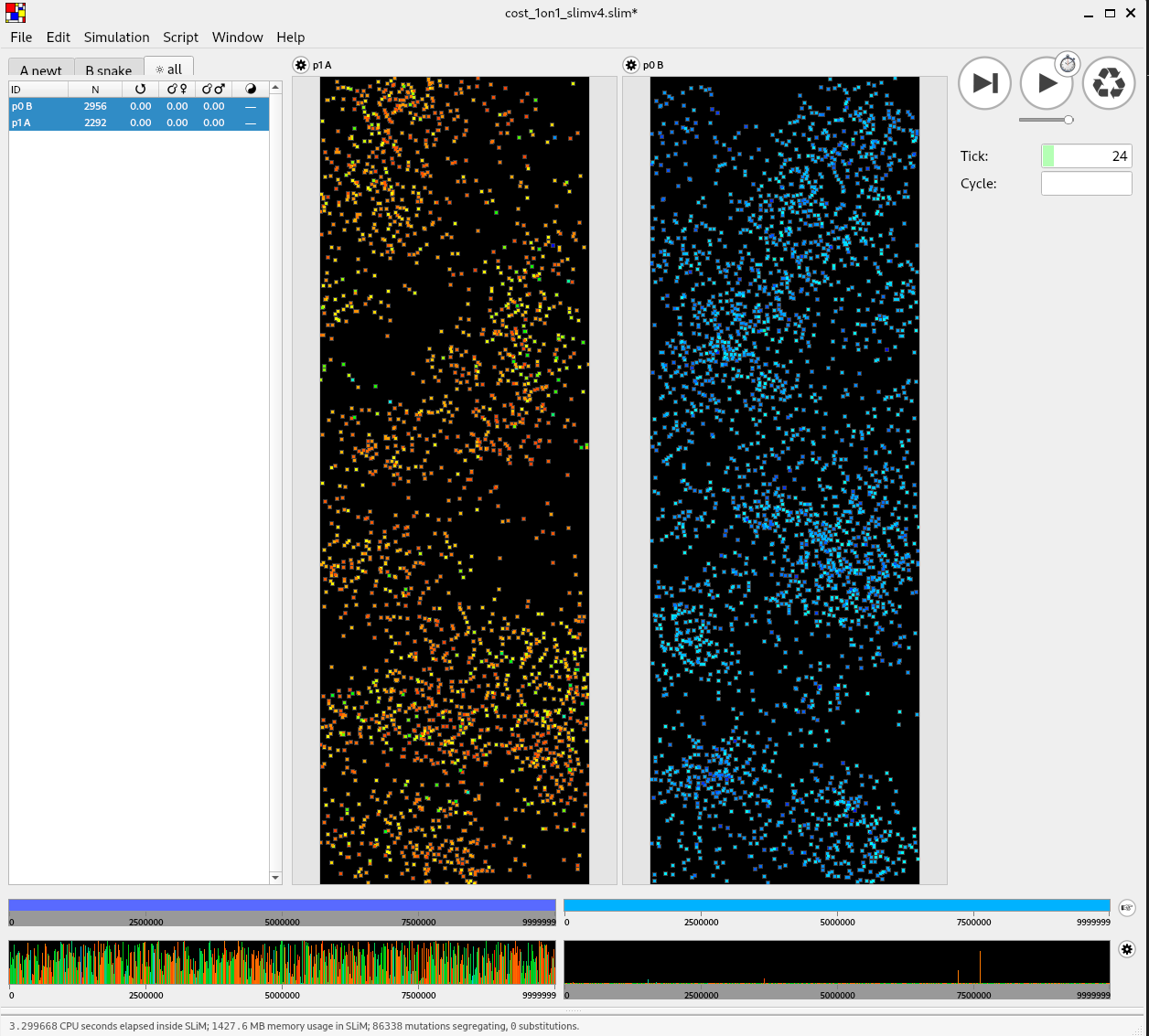
No spatial correlation on a flat map
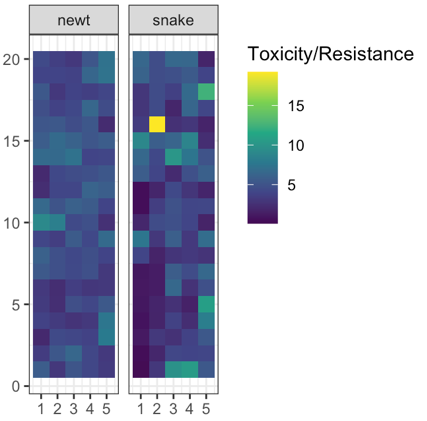
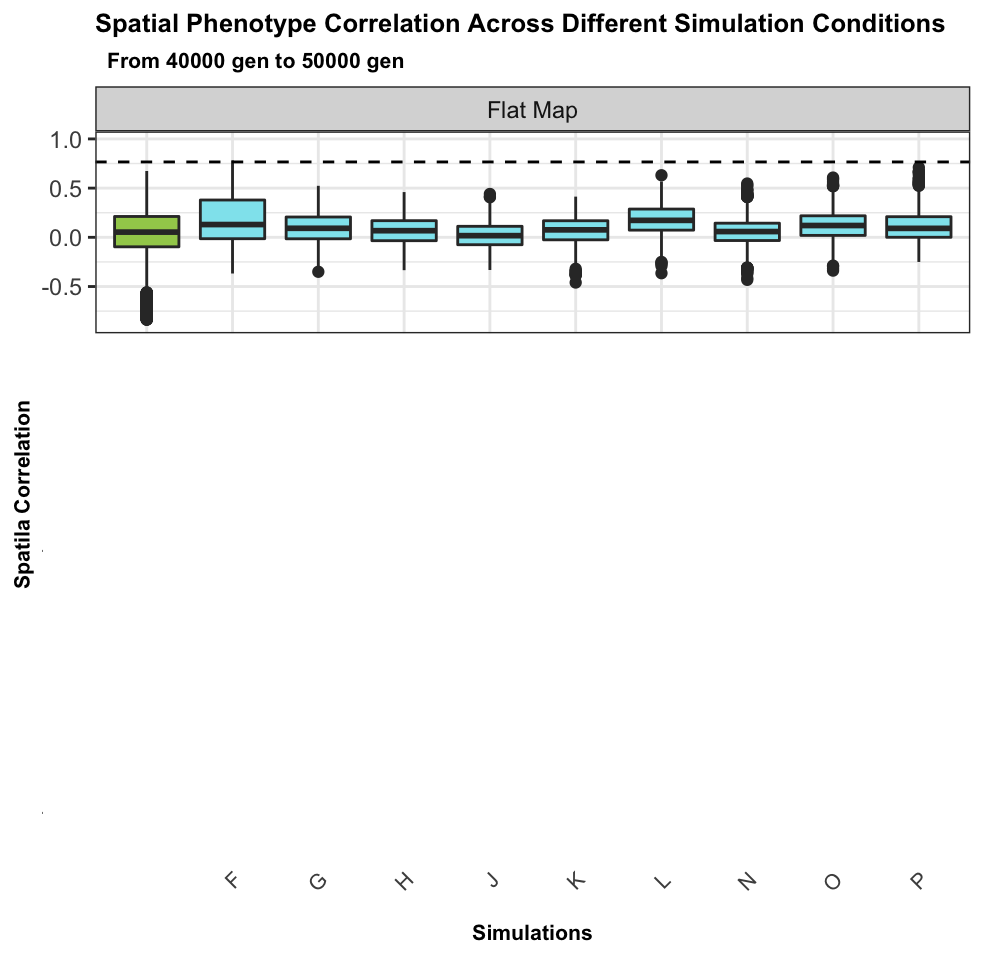
Add some heterogeneity
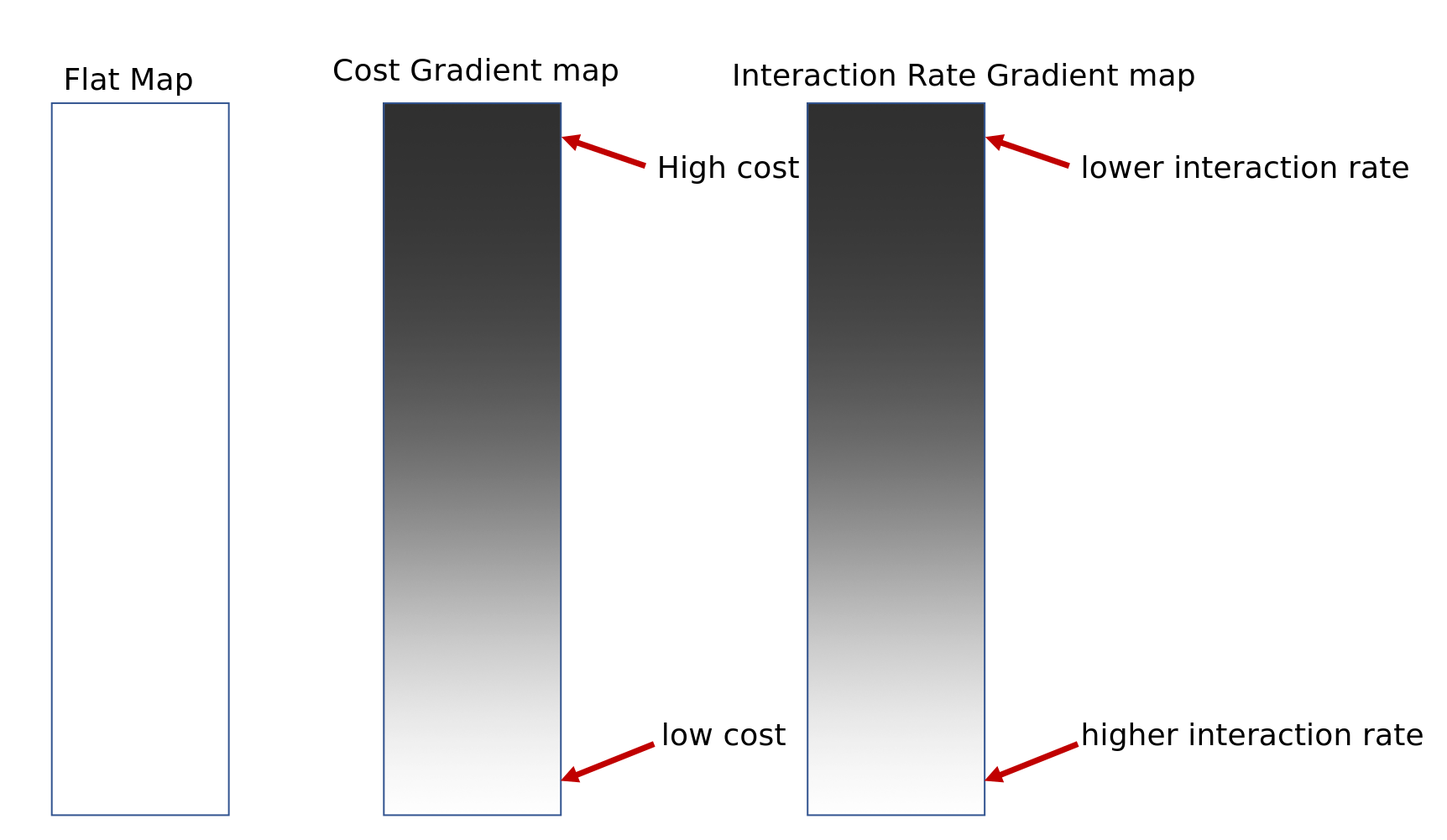
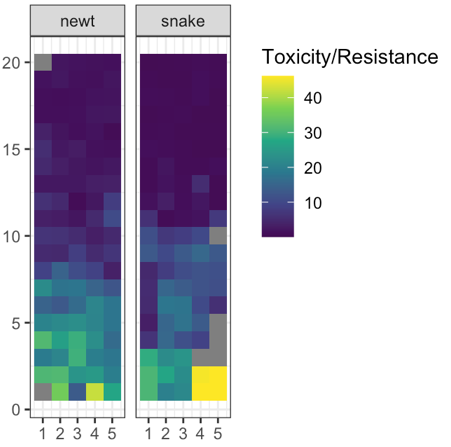
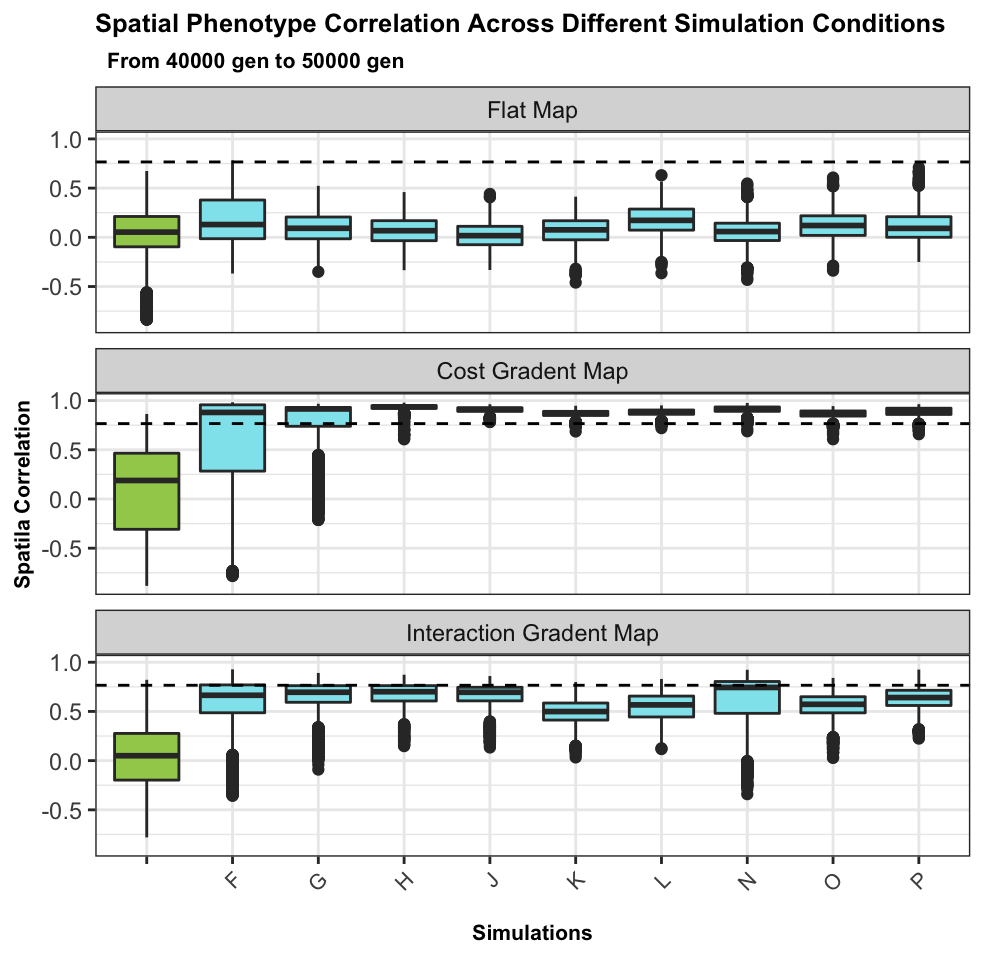
Conclusions

such large correlated differences across the landscape unlikely to be due to nonadaptive forces
spatial heterogeneity in ecological factors much more plausible
trait genetic architecture has little effect, given sufficient variation

Victoria Caudill
Landscapes of genetic diversity
Landscapes of genetic diversity within groups of species
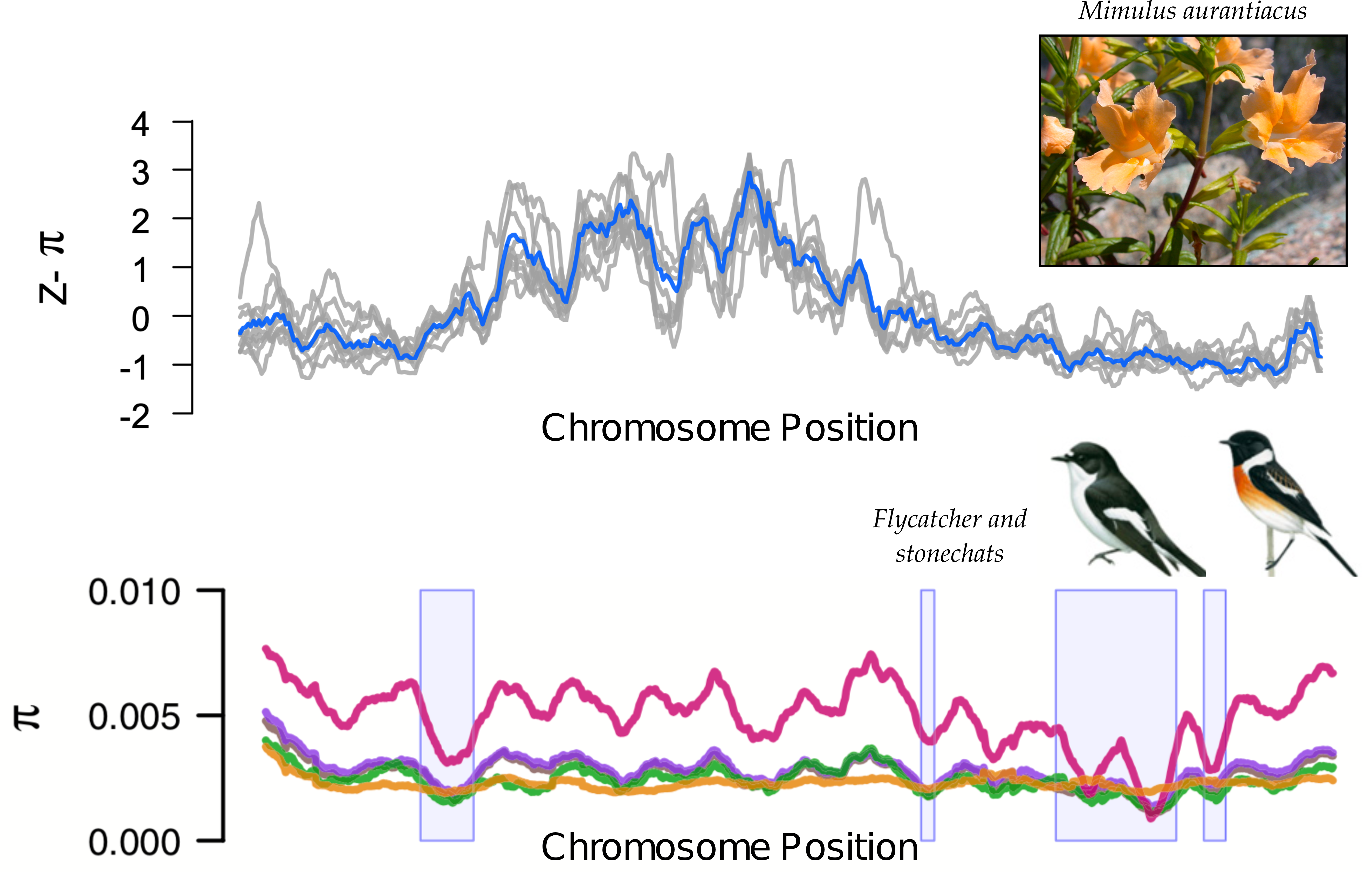
The study system: “us”
- High quality genomic data for 5 species
- Deep divergence, spanning ~60N generations
- Conservation of genes, recombination rate and other genomic features
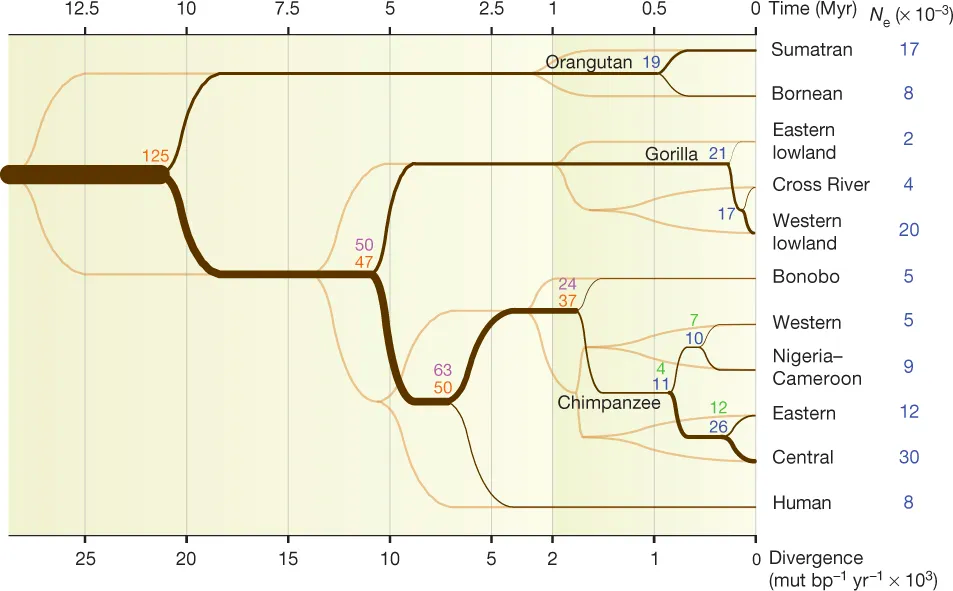
Genetic diversity in the great apes: chromosome 12
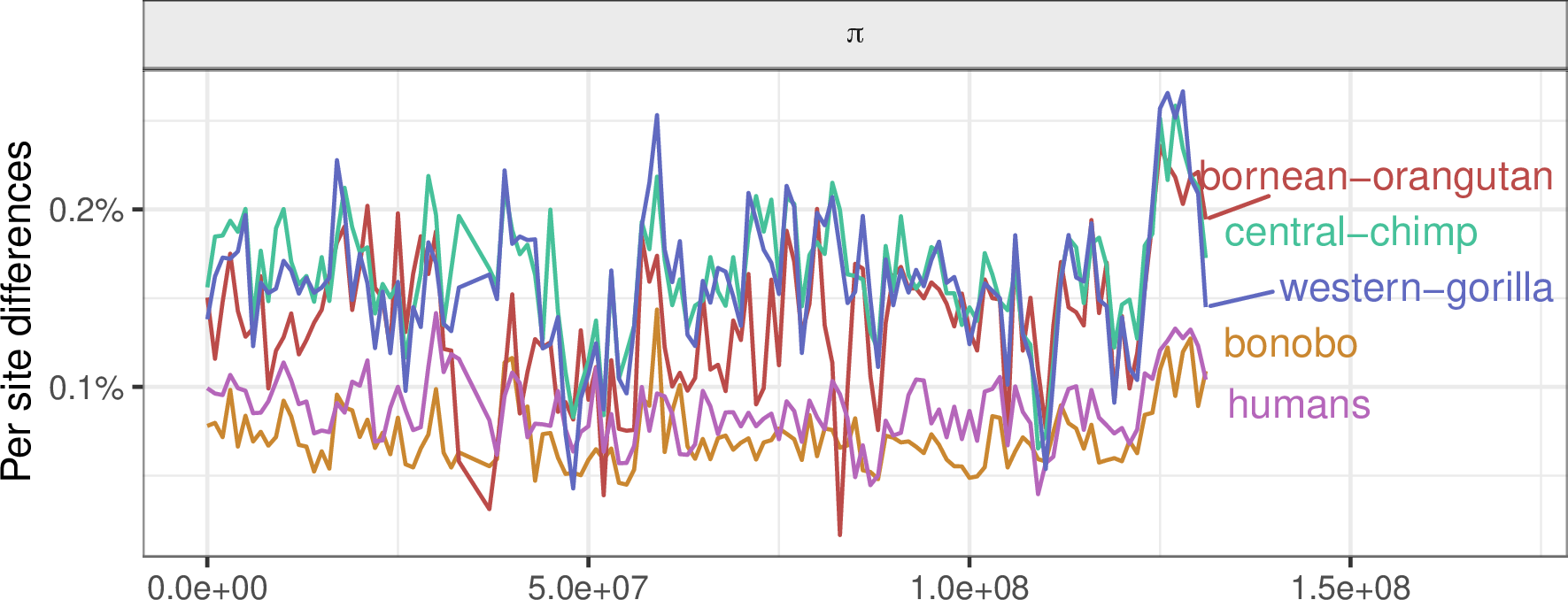
Genetic divergence between the great apes: chromosome 12
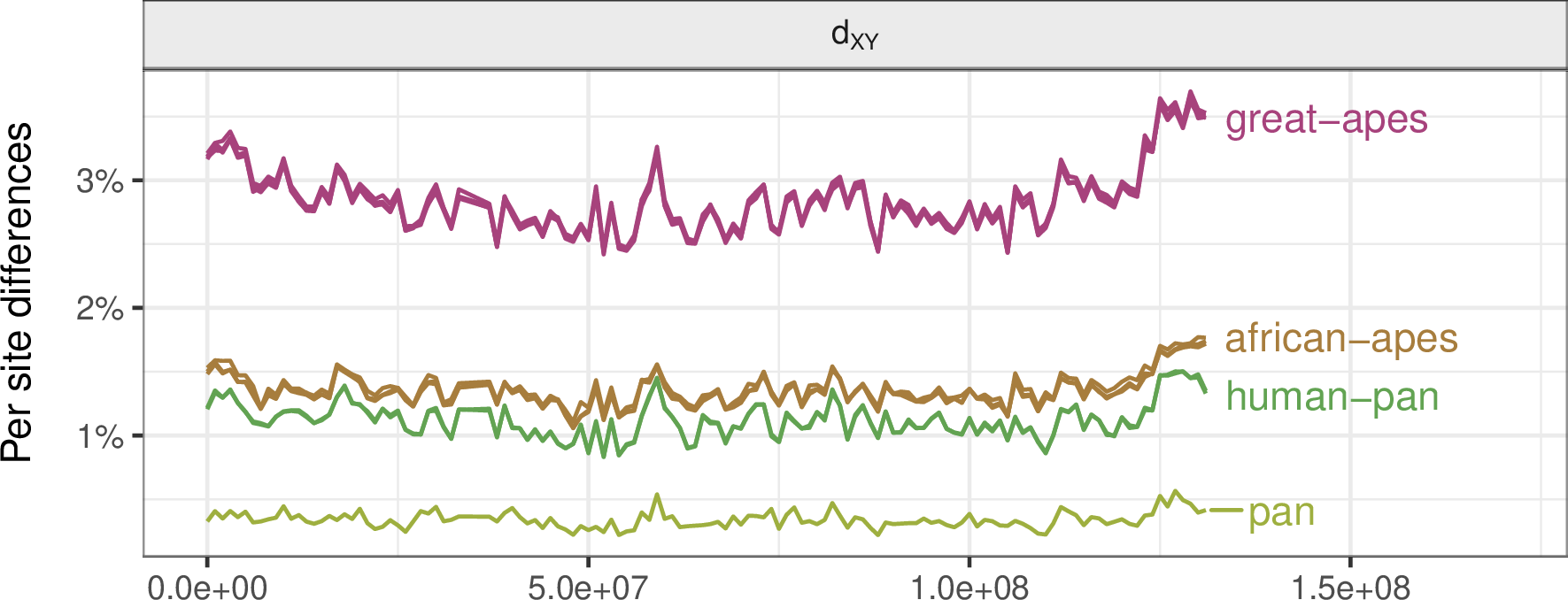
Goals
- How correlated are landscapes for closely related species?
- How much is due to shared footprints of
- history?
- selection? what kind?
- mutational processes?

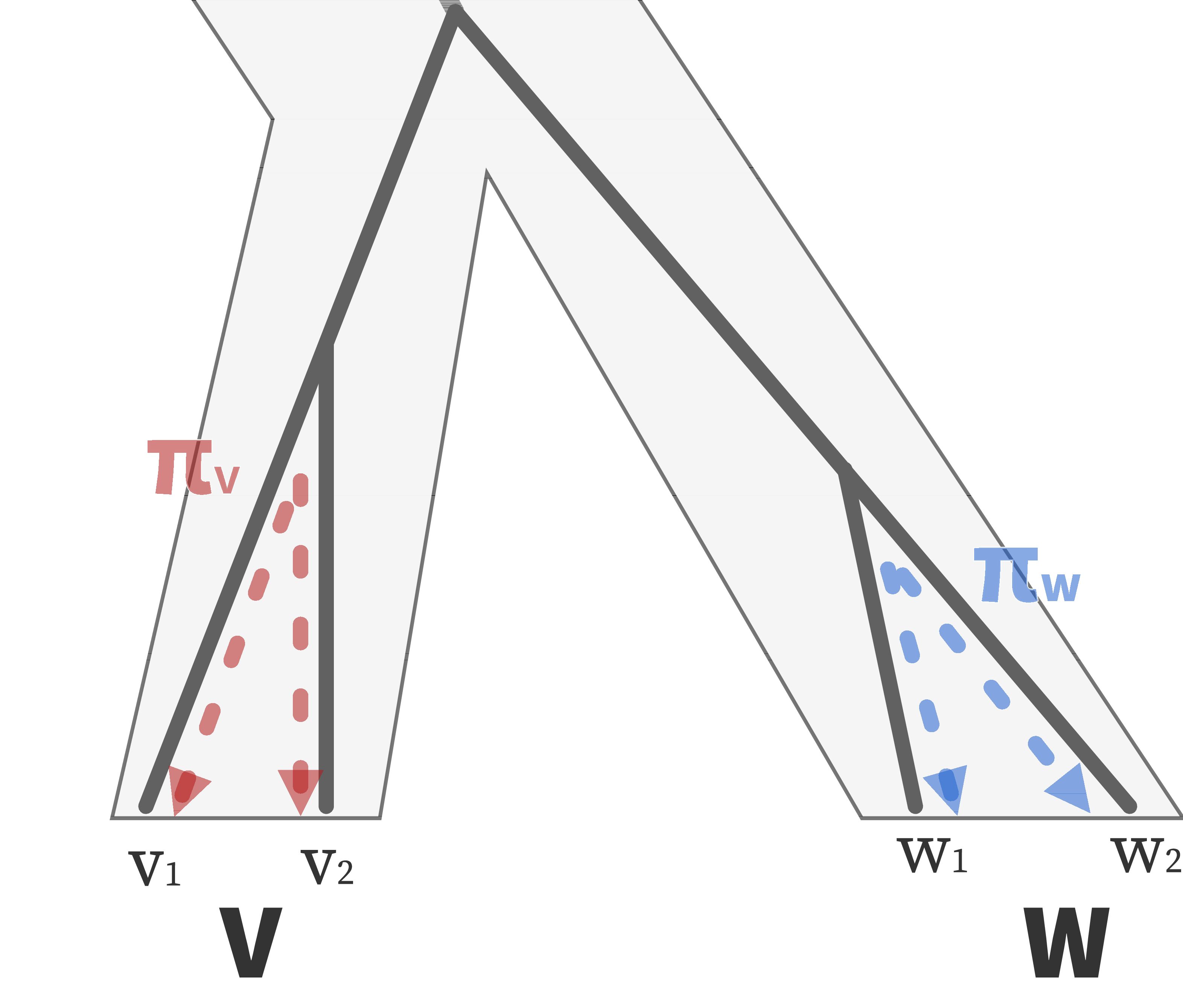
A quick primer
- Genetic diversity (\(\pi\)) and divergence (\(d_{XY}\)) are time since common ancestor multiplied by effective mutation rate: \[ \pi, d_{XY} = T_\text{MRCA} \times \mu_\text{effective} . \]
- Higher mutation rate \(\Rightarrow\) higher \(\pi\) and faster increase of \(d_{XY}\).
- Positive selection increases fixation rate of new mutations \(\Rightarrow\) \(d_{XY}\) goes up faster,
- … but, it decreases \(\pi\) nearby.
linked selection: The indirect effects of selection on genomic locations that are linked to the sites under selection by a lack of recombination.
Selection tends to decrease diversity, over a distance determined by recombination rate.
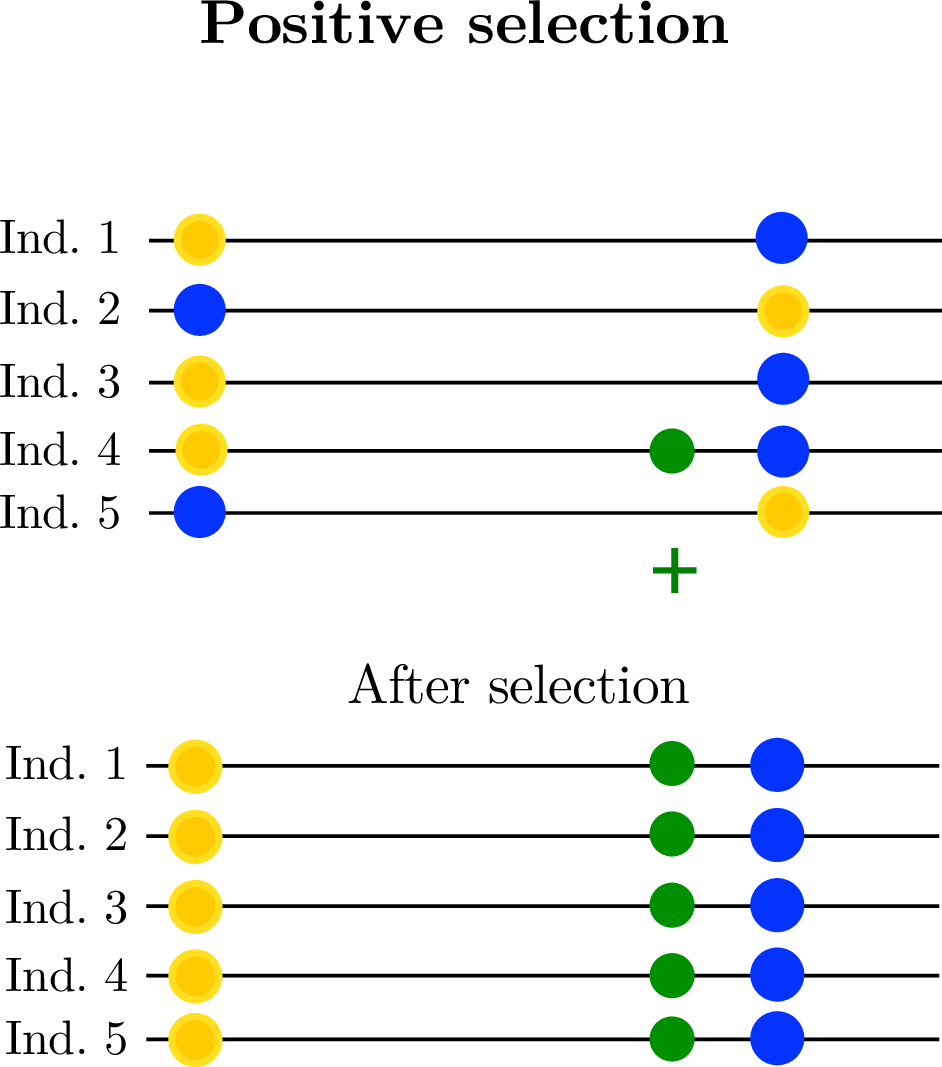
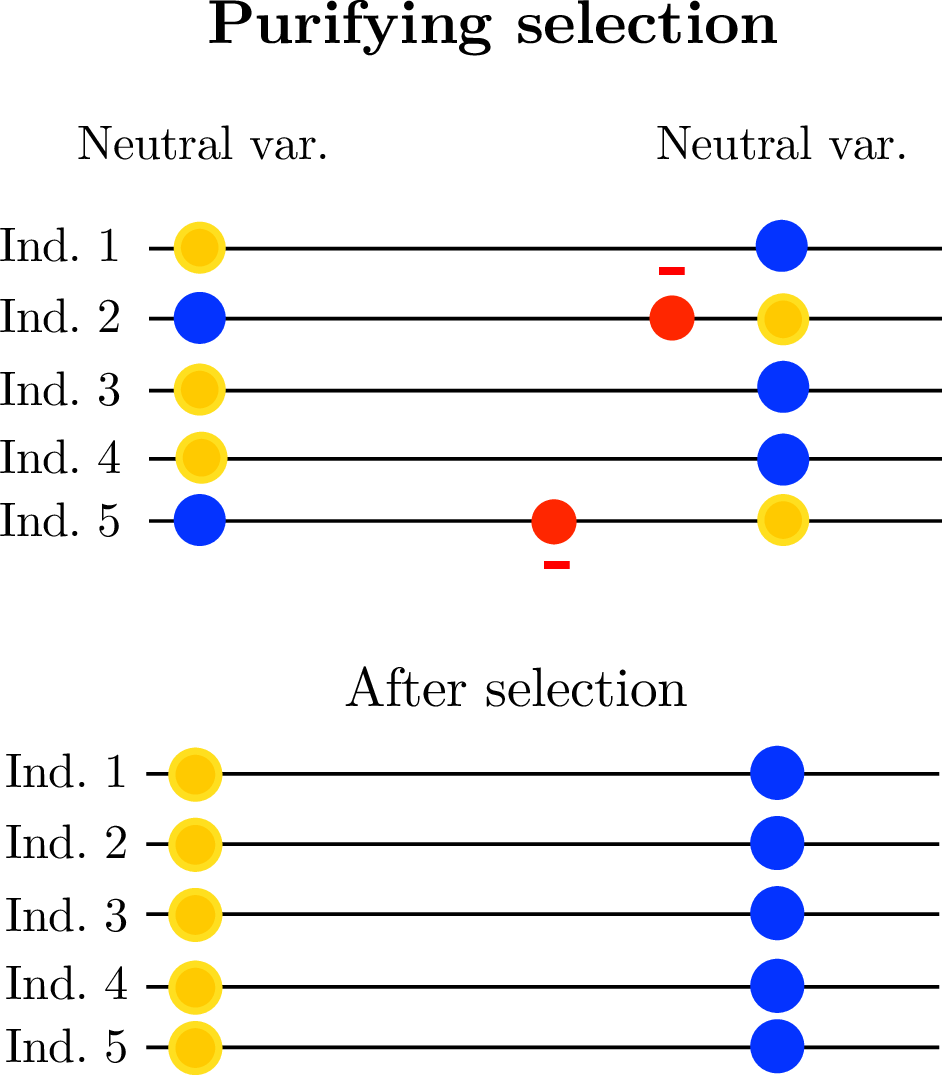
Diversity correlates with recombination rate
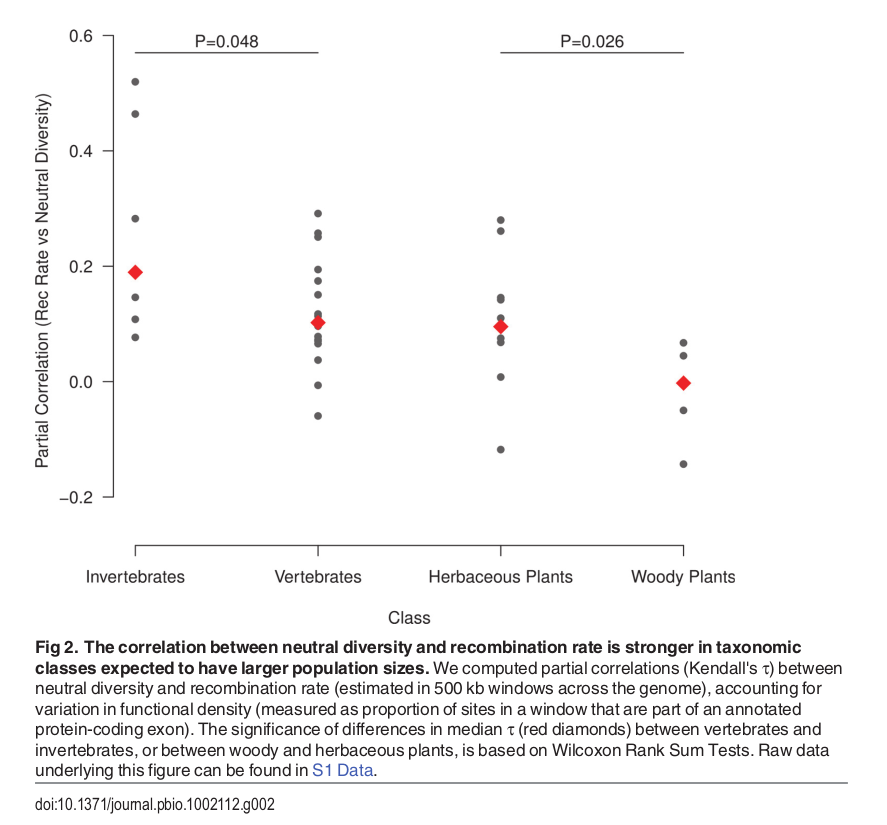
Hudson 1994; Cutter & Payseur 2013; Corbett-Detig et al 2015
How diversity landscapes change
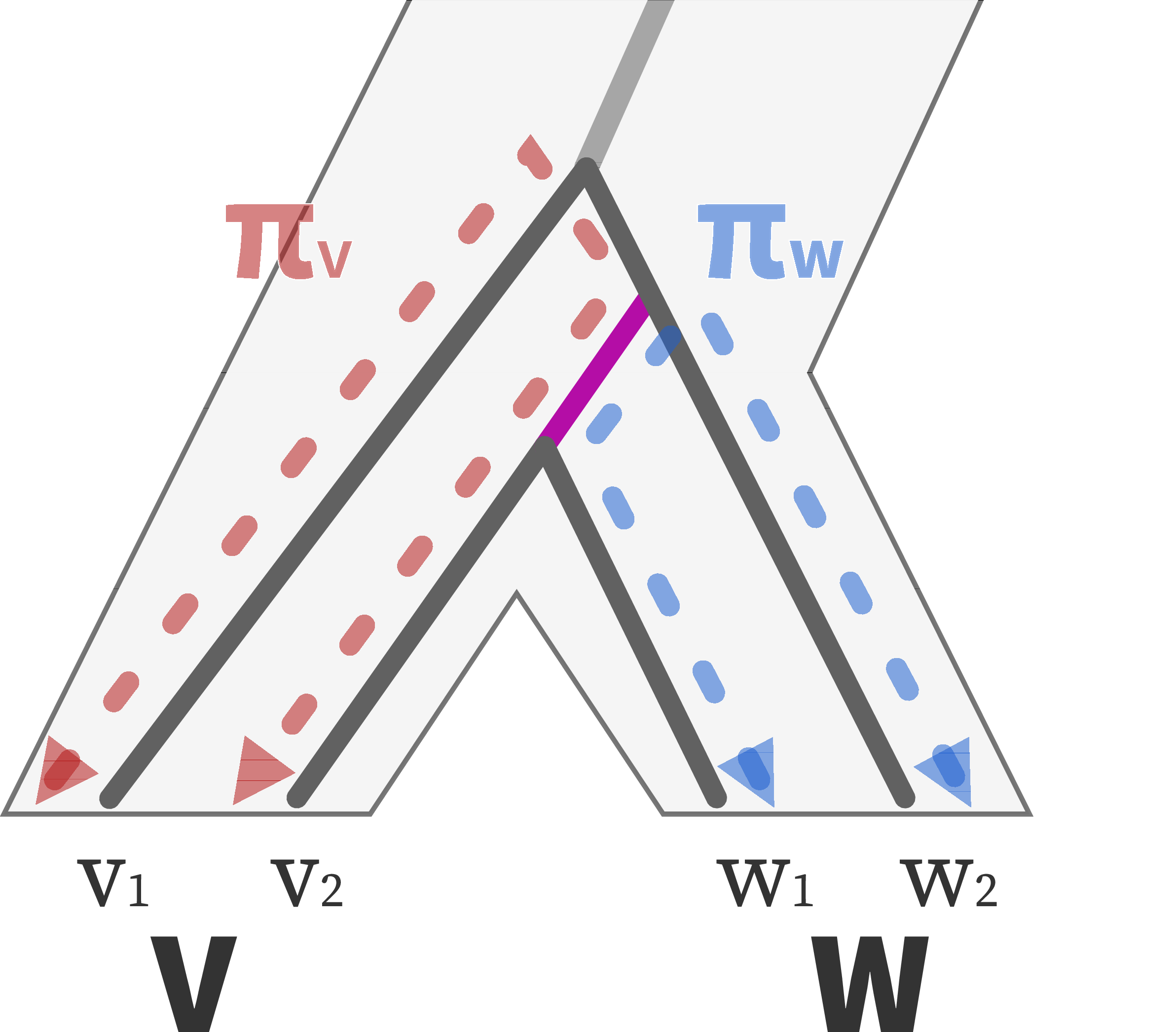
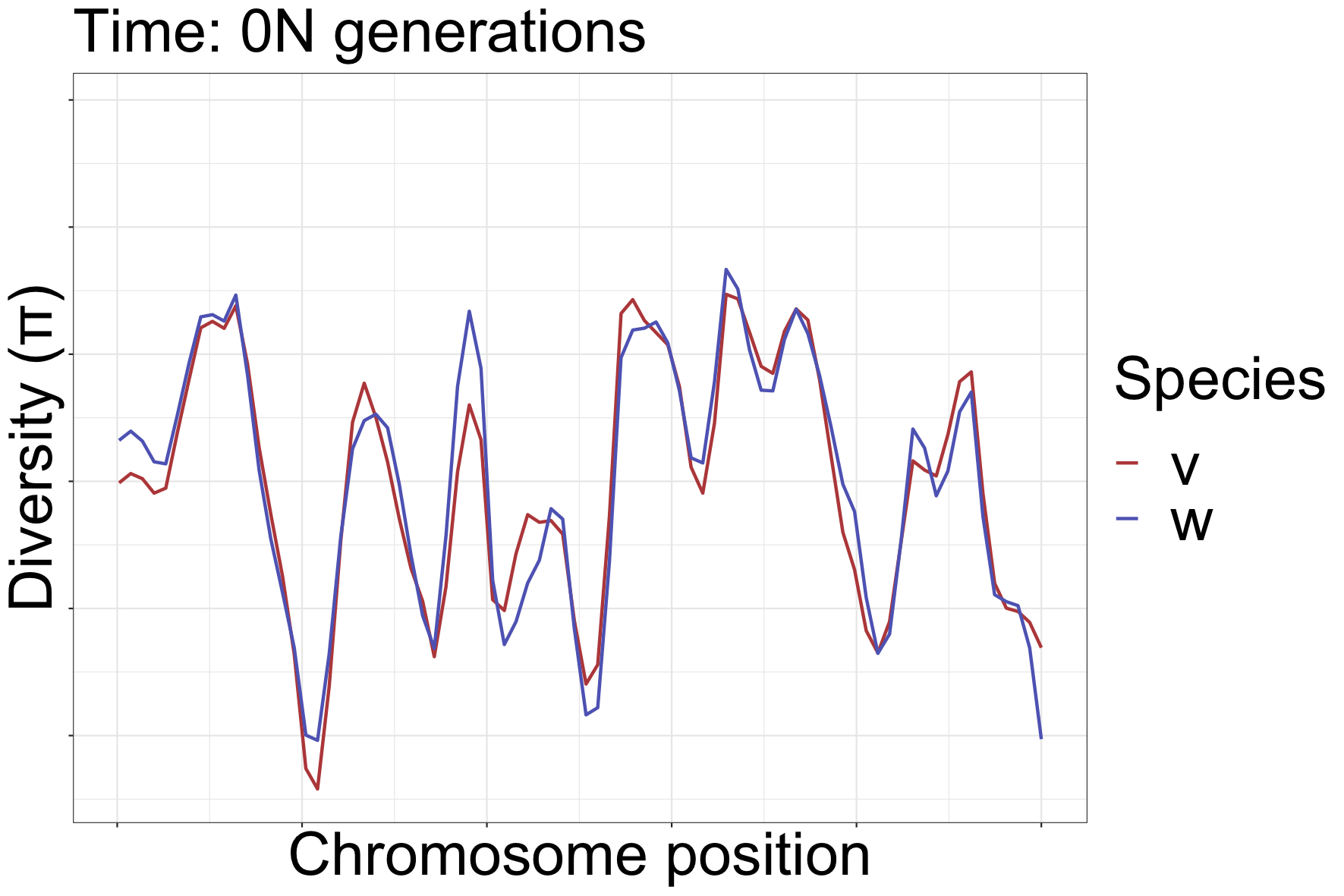
How diversity landscapes change
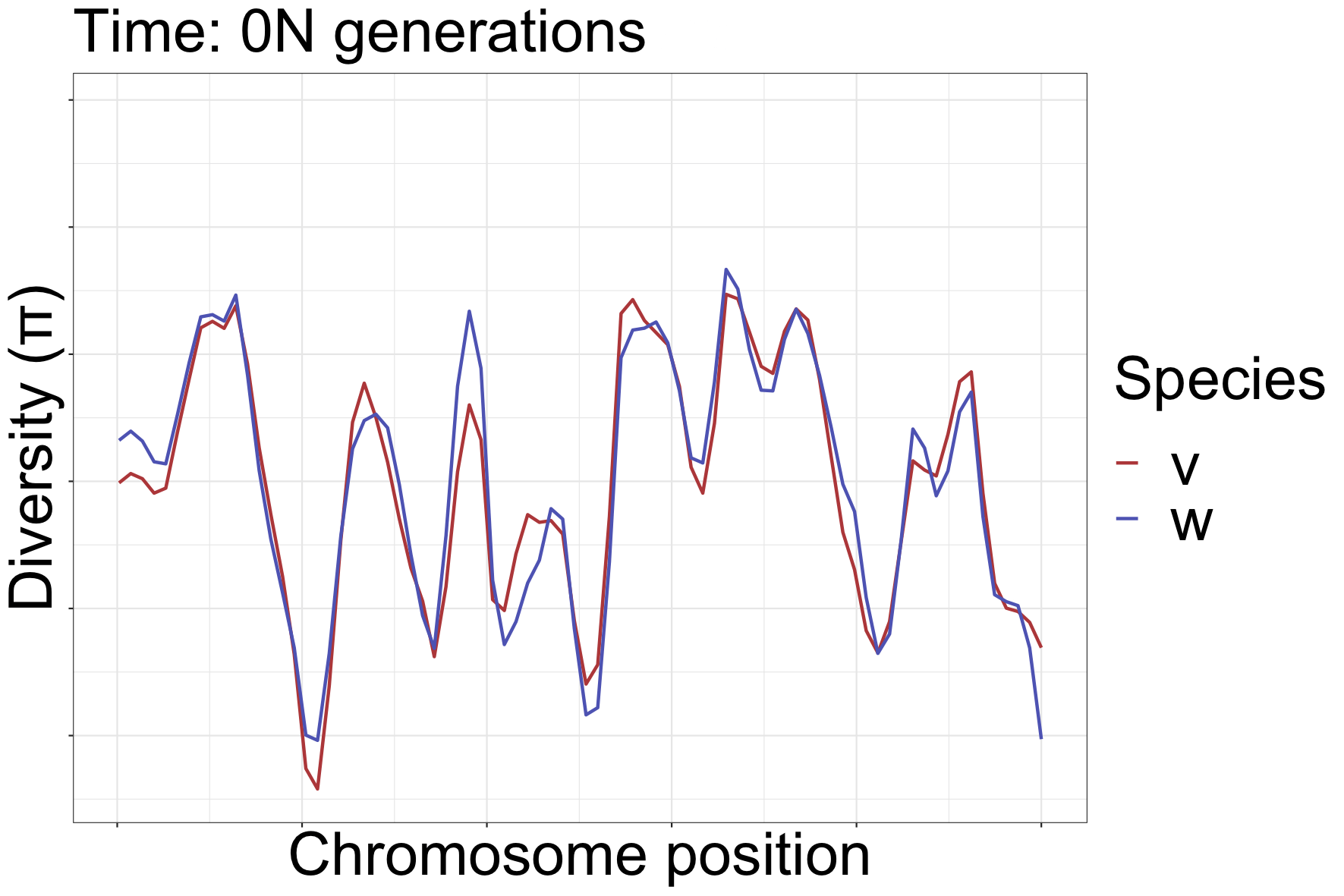
How diversity landscapes change

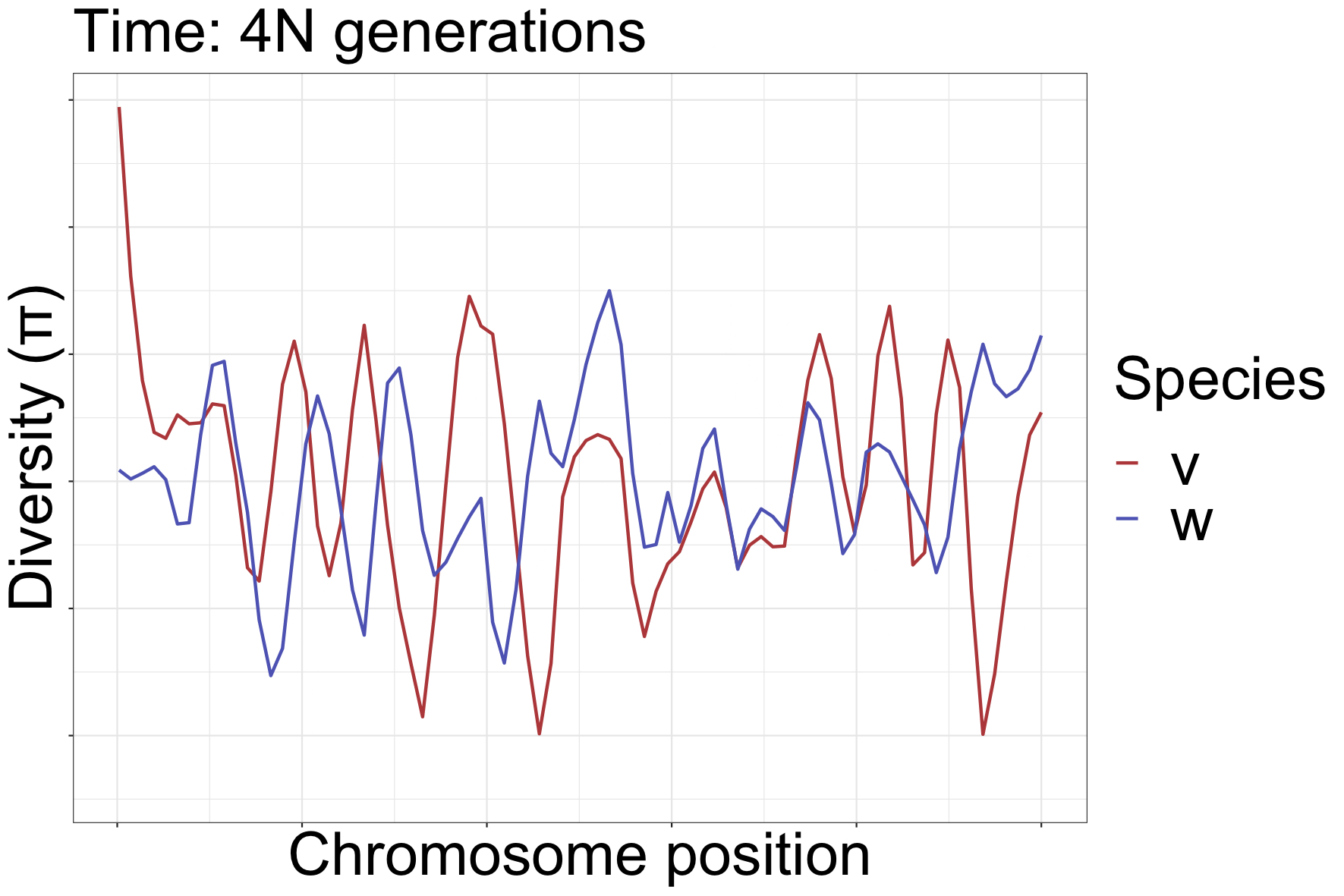
How can landscapes stay correlated?
- shared processes:
- positive, negative selection
- mutation rate variation
- GC-biased gene conversion
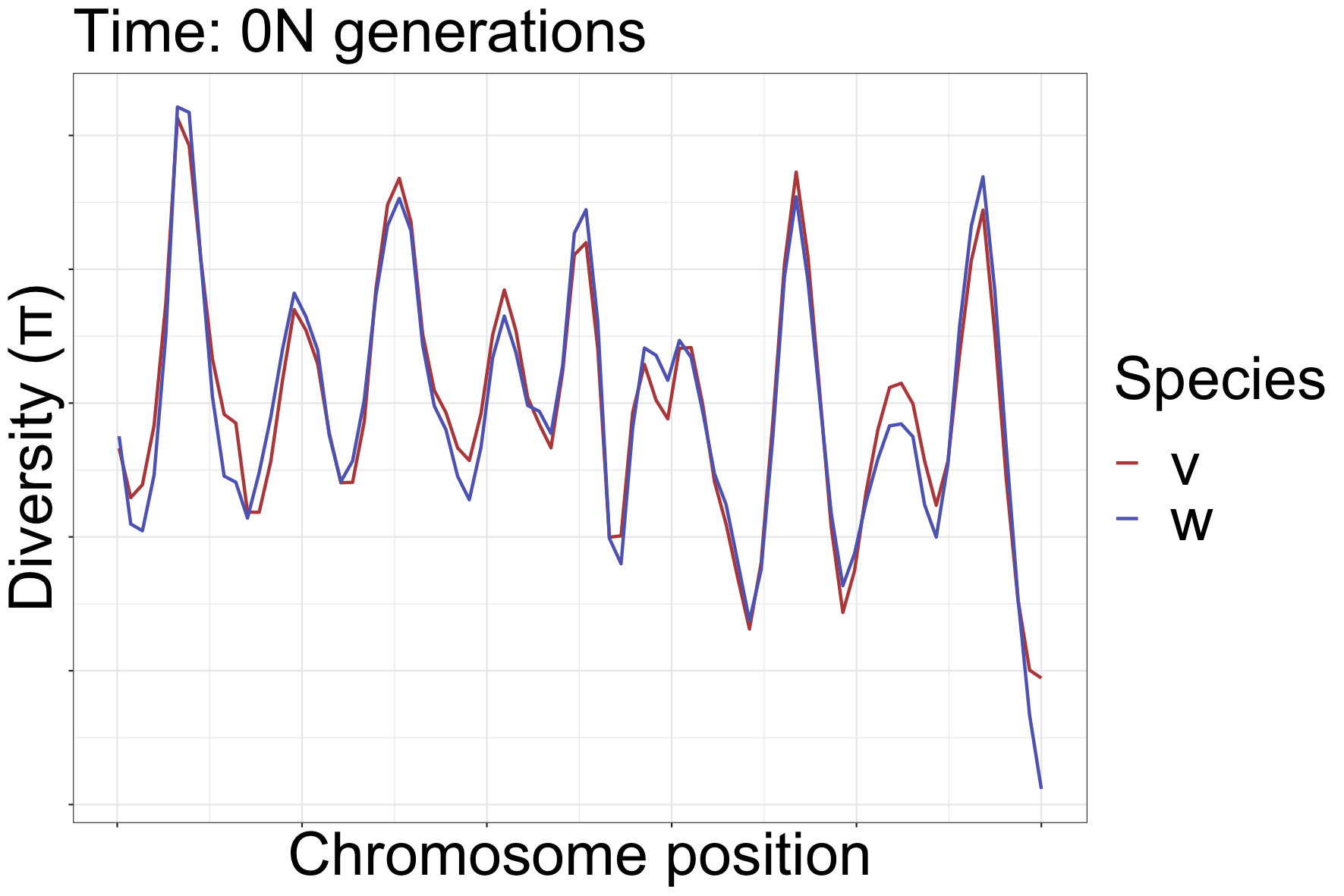
How can landscapes stay correlated?
- shared processes:
- positive, negative selection
- mutation rate variation
- GC-biased gene conversion
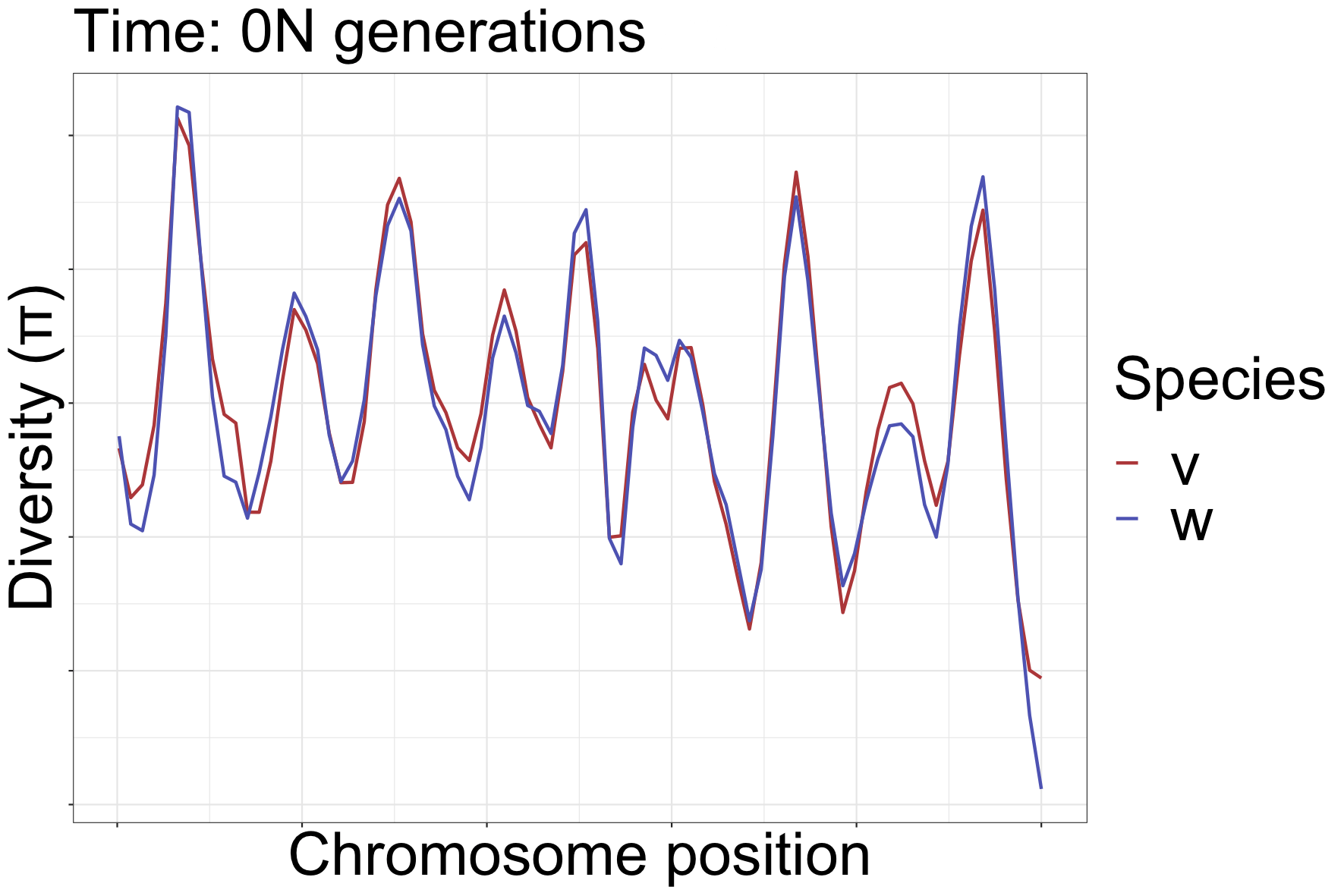
How can landscapes stay correlated?
- shared processes:
- positive, negative selection
- mutation rate variation
- GC-biased gene conversion
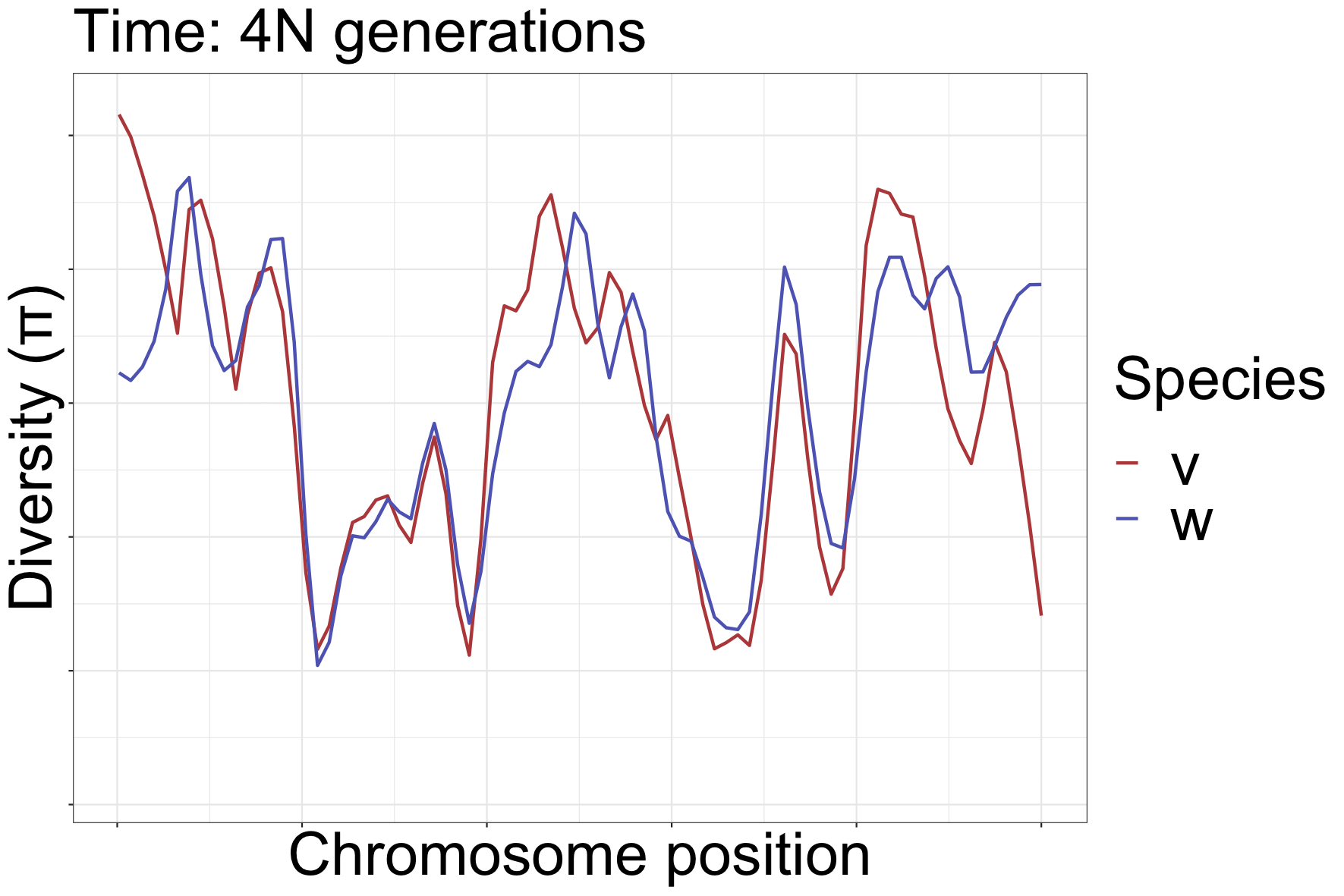
SLiMulations
Back to the data


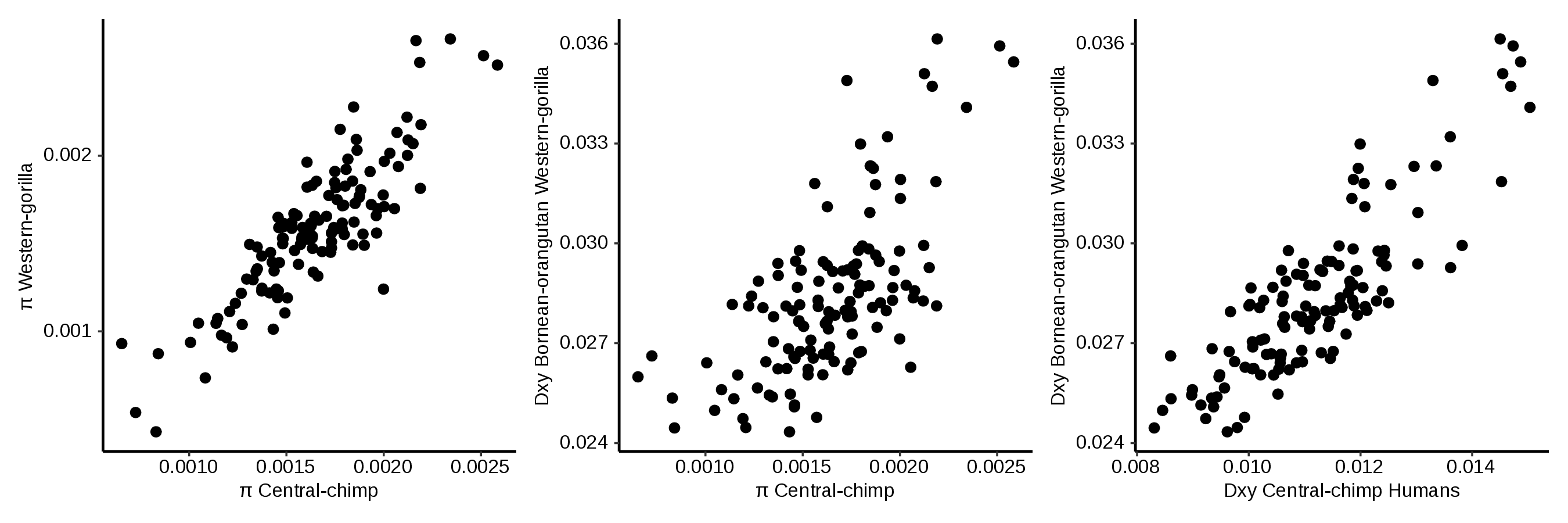

The data: empirical correlations for chromosome 12 in the great apes
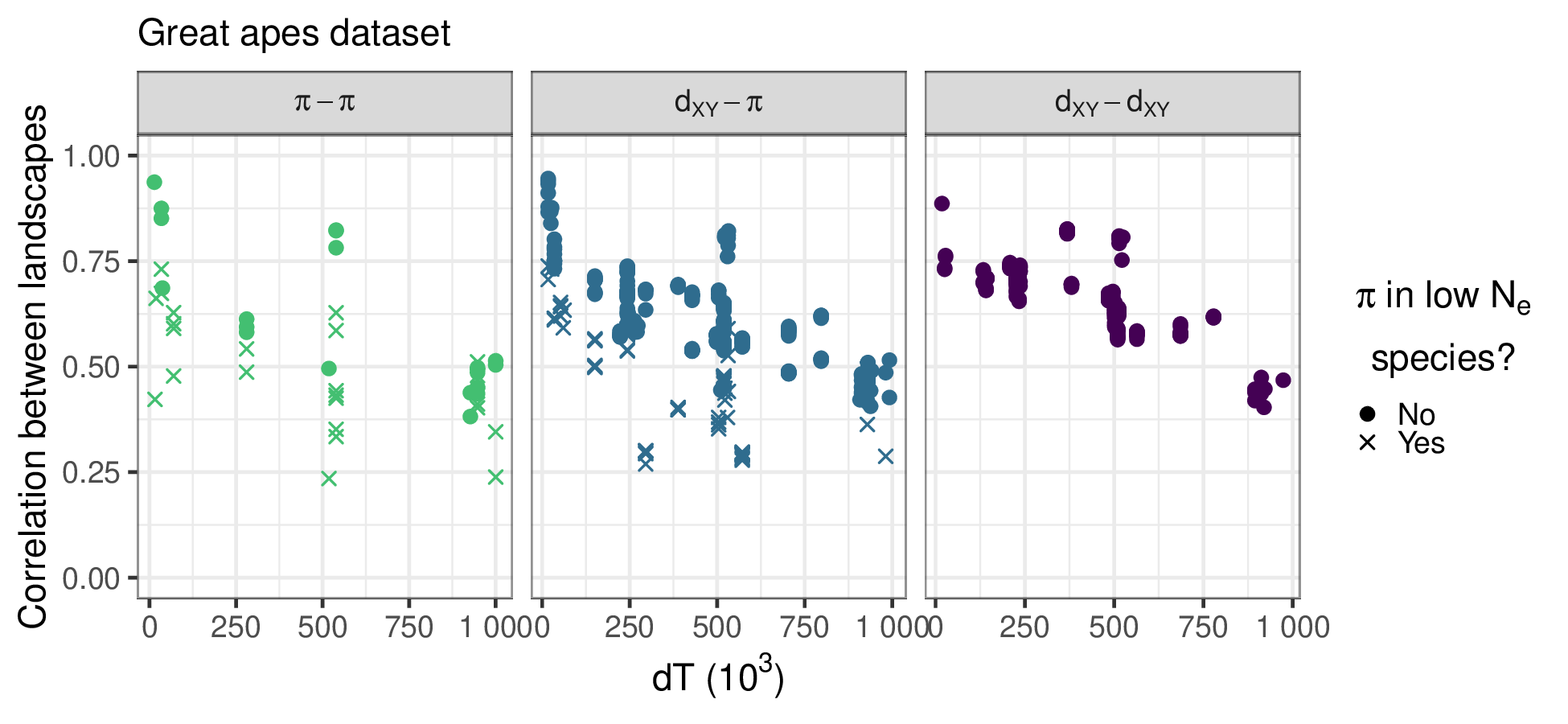
No correlation under neutrality
- correlations decay to zero quickly with split time
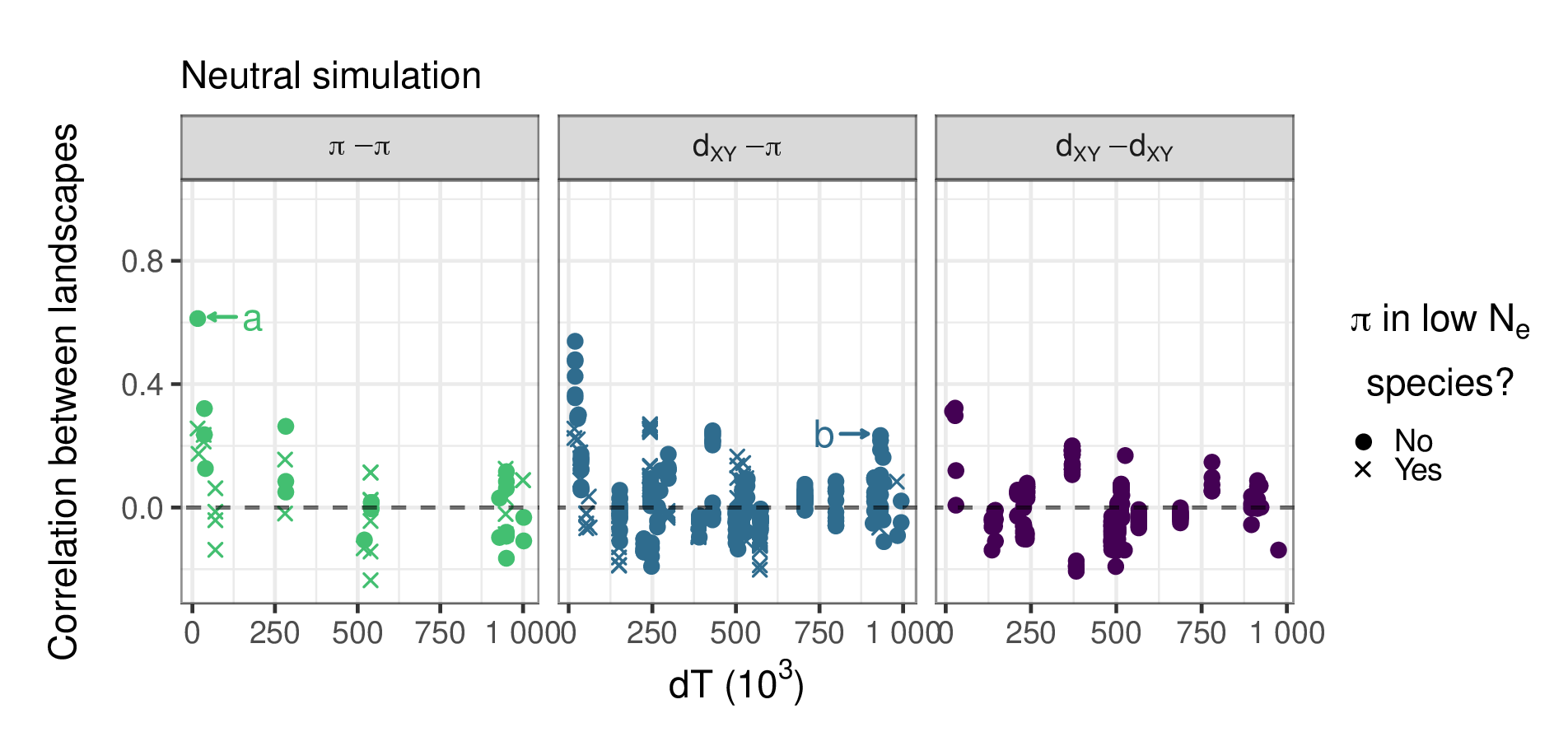
Mutation rate variation can contribute
- but correlations do not decay with time
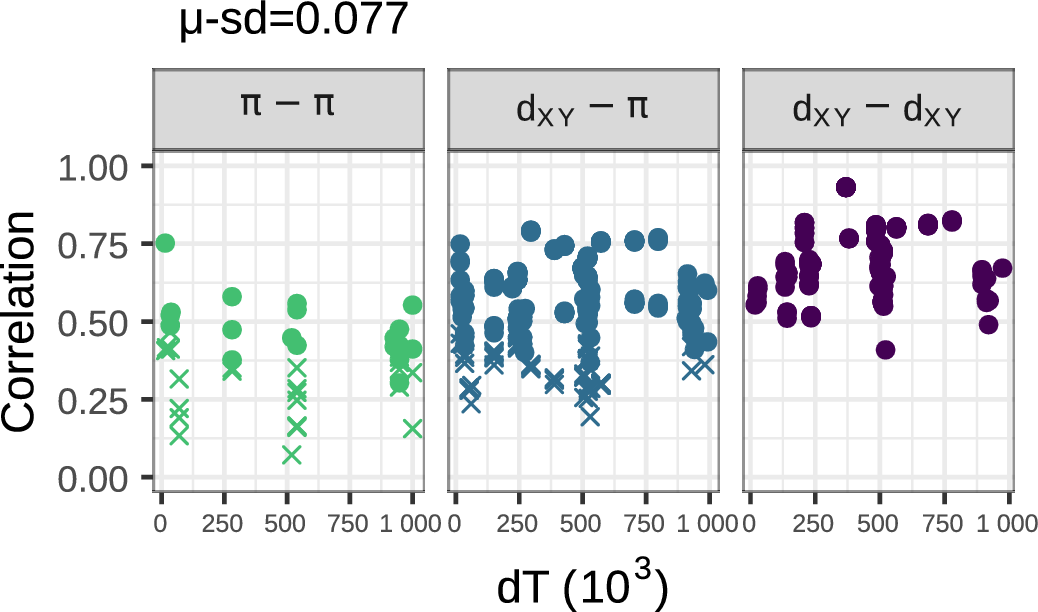
Negative selection produces weak correlations

Positive selection produces strong correlations
- sometimes too strong
\[ \vphantom{ d_{xy} = \pi_\text{anc} \nearrow + \mu T_\text{MRCA} \searrow } \]

The best fit: both!
- chosen from 37 distinct simulations
- deleterious mutations: \(1.2 \times 10^{-8}\)
- beneficial mutations: \(10^{-12}\)

Conclusions
- positive selection most necessary for a good fit
- best guess: \(\approx 10\%\) of fixations on human lineage due to positive selection (1/250 years);
- \(\approx\) 70% of mutations in exons deleterious
- fixation rate in exons reduced by half
- GC-biased gene conversion causes “smile” at ends of chromosomes

Wrap-up
Other applications
- history of Nebria beetles (Gilia Patterson, Sean Schoville, Yi-Ming Weng)
- inference of mean dispersal distance (Chris Smith; disperseNN)
- and of maps of effective density and dispersal distance (Chris Smith; mapNN)
- inference of recombination rate maps (Jeff Adrion; ReLERNN)
- inference of maps of population density (Gilia Patterson)
- and individual movement
- identification of regions under selection
Software development goals
- open
- welcoming and supportive
- reproducible and well-tested
- backwards compatible
- well-documented
- capacity building

Thanks!
- Andy Kern
- Victoria Caudill
- Murillo Rodrigues
- Gilia Patterson
- Chris Smith
- Nate Pope
- Jiseon Min
- Clara Rehmann
- Bruce Edelman
- Anastasia Teterina
- Matt Lukac
- the rest of the Co-Lab
Funding:
- NIH NIGMS
- NSF DBI
- Jerome Kelleher
- Ben Haller
- Ben Jeffery
- Yan Wong
- Elsie Chevy
- Madeline Chase
- Sean Stankowski
- Matt Streisfeld
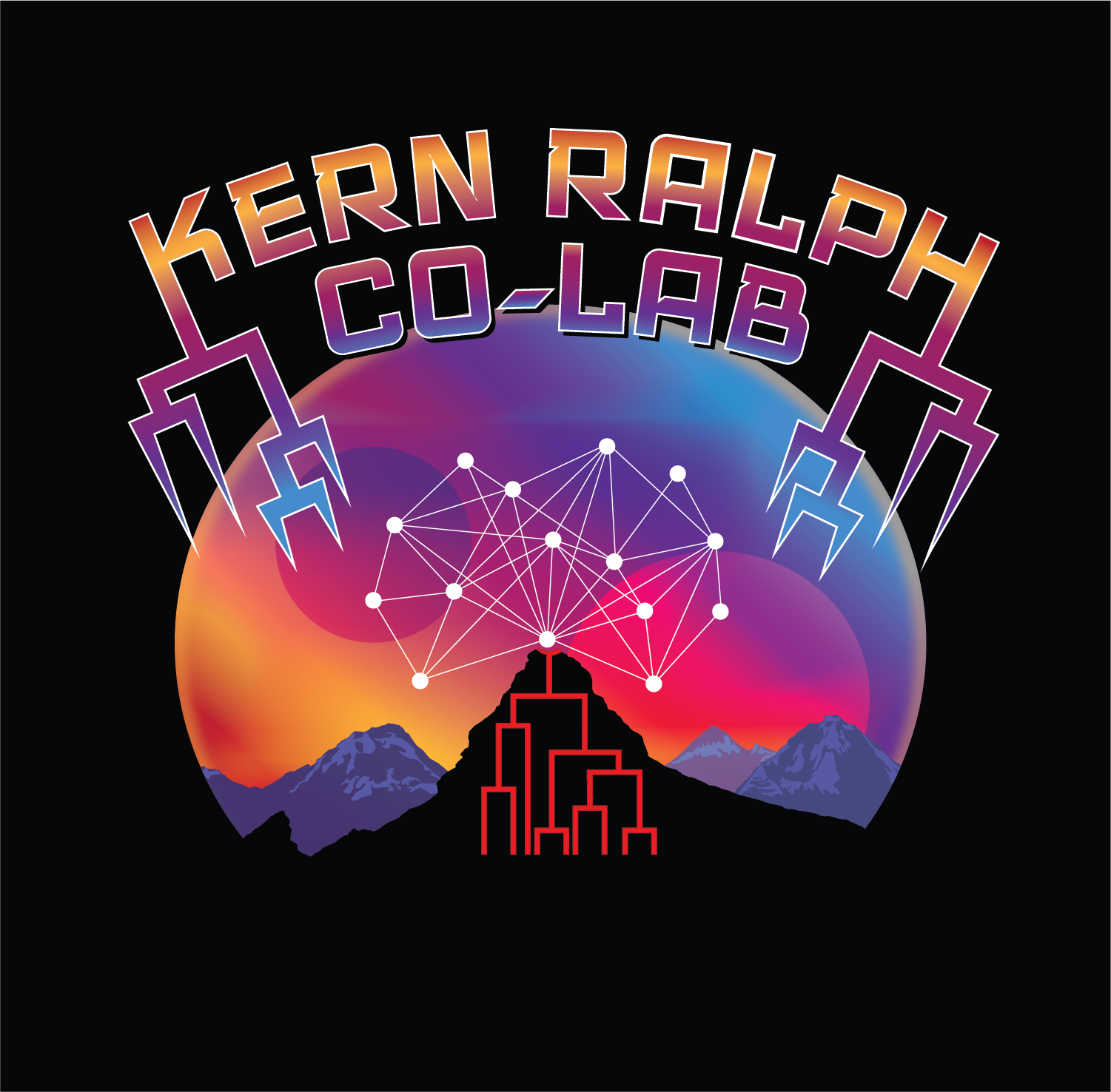



Beetles in the mountains
Nebria ingens/riversi
- ground beetles
- live on flowing snowmelt in the Sierra Nevada of California
- cannot fly
- live 1–2 years
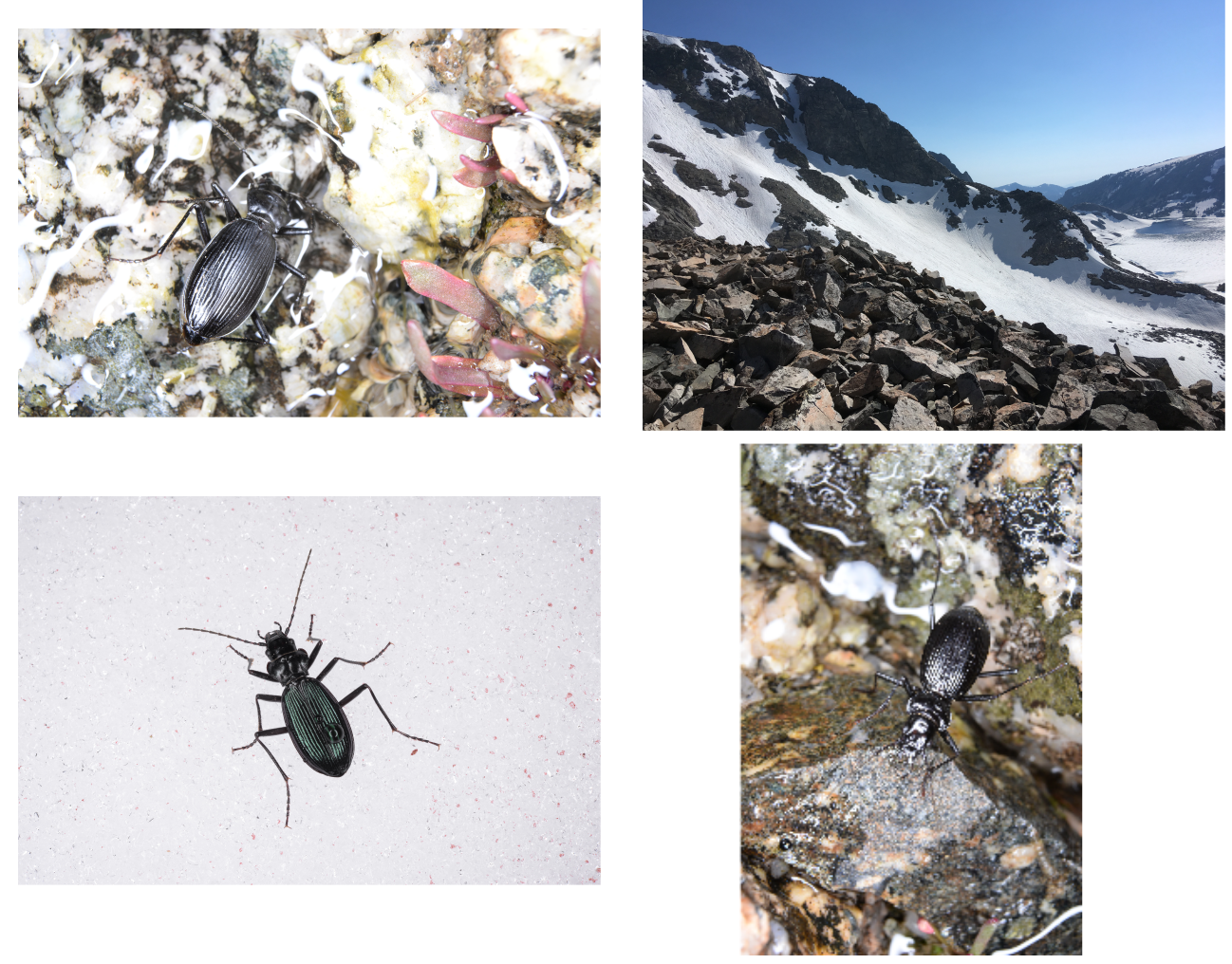
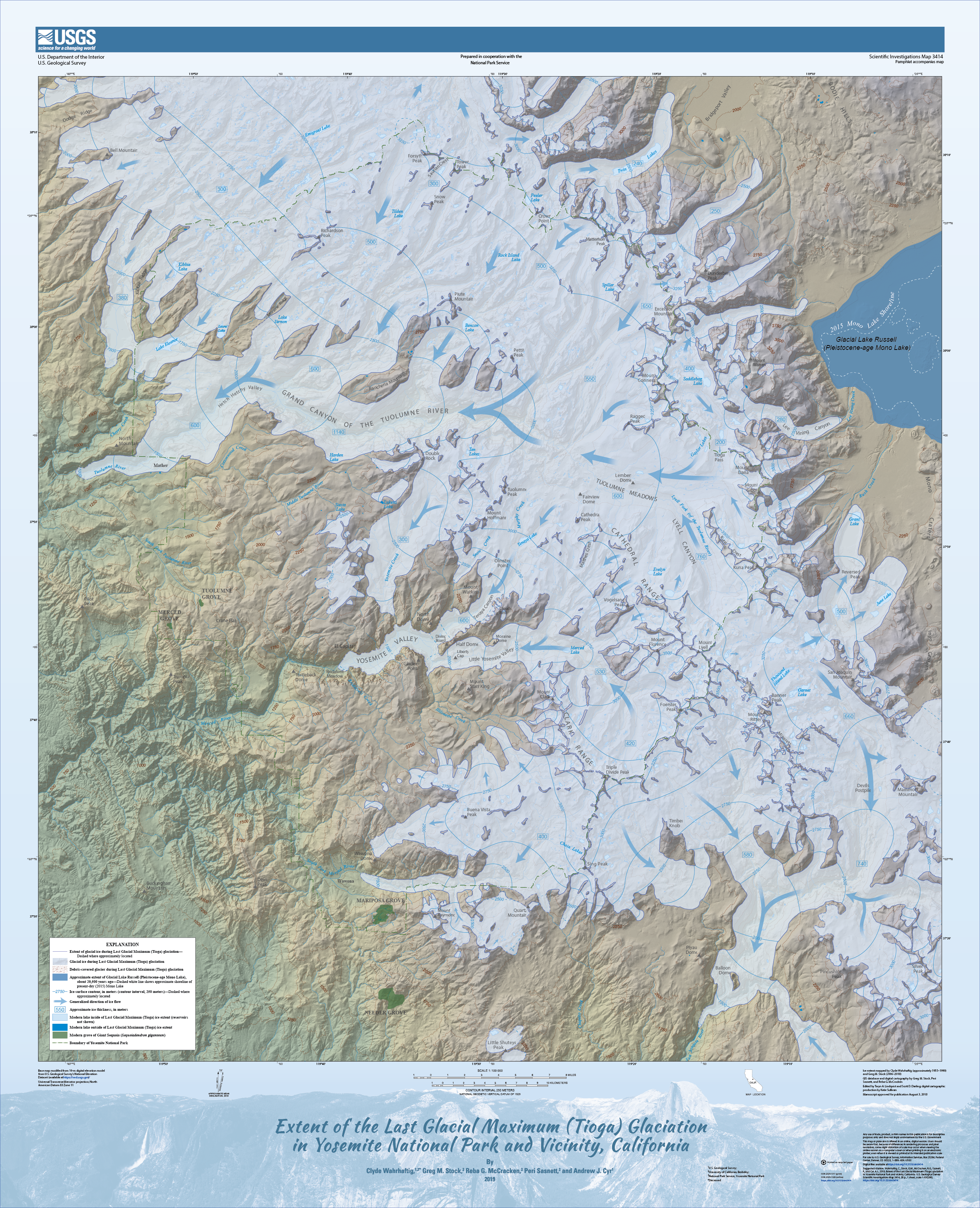
Good habitat followed the glaciers uphill (SDM by Yi-Ming Weng).
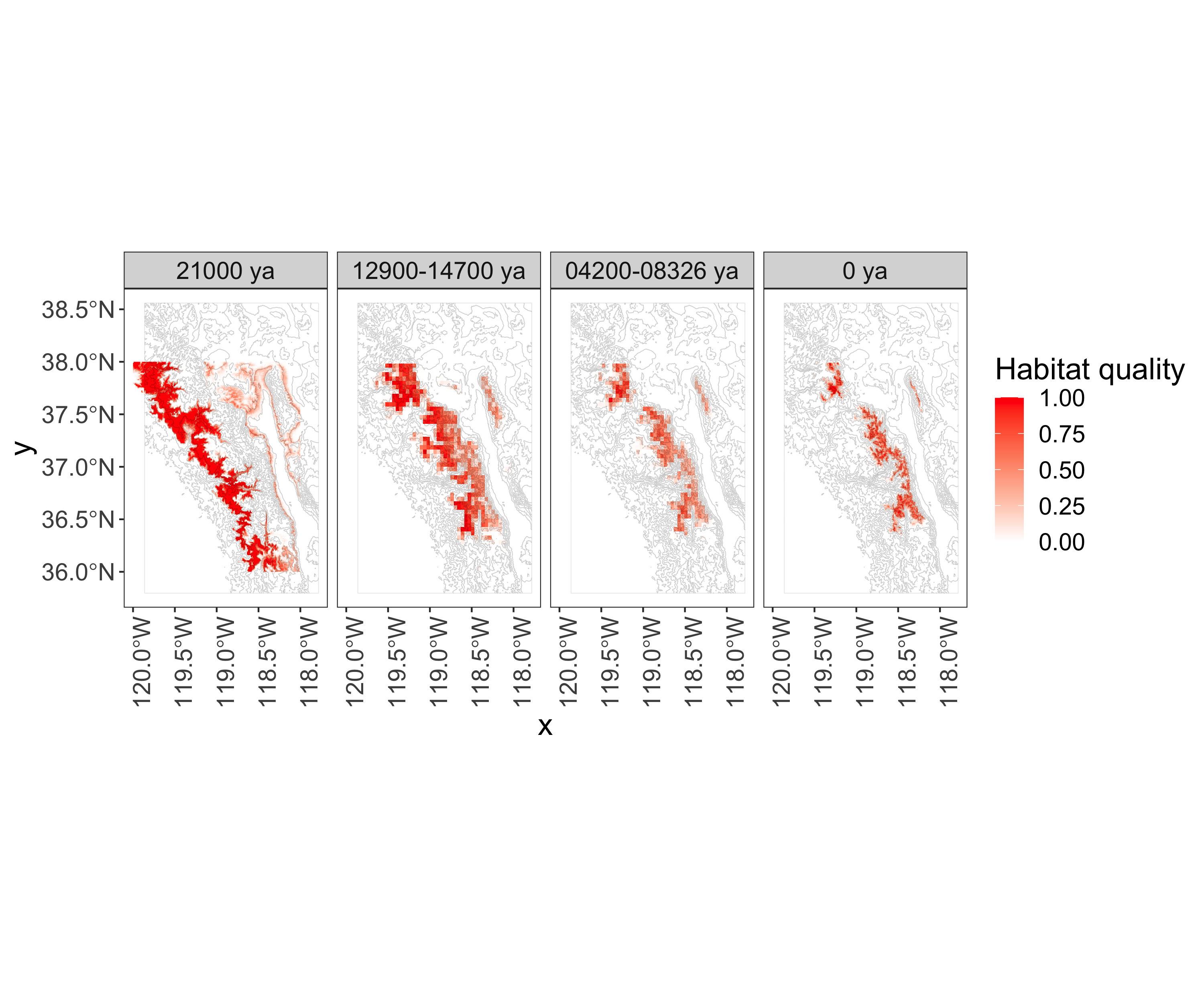
Goals
- What was the spatial demographic history of Nebria since the LGM?
- Where did the ancestors of today’s beetles live in the past?
- Were the ancestors of N. ingens and N. riversi distinct at the LGM?

Data
Collected by Yi-Ming Weng and Sean Schoville:
- 384 beetles at 27 sites
- low coverage WGS
- some presence/absence data
- expert knowledge about good locations
- a species distribution model
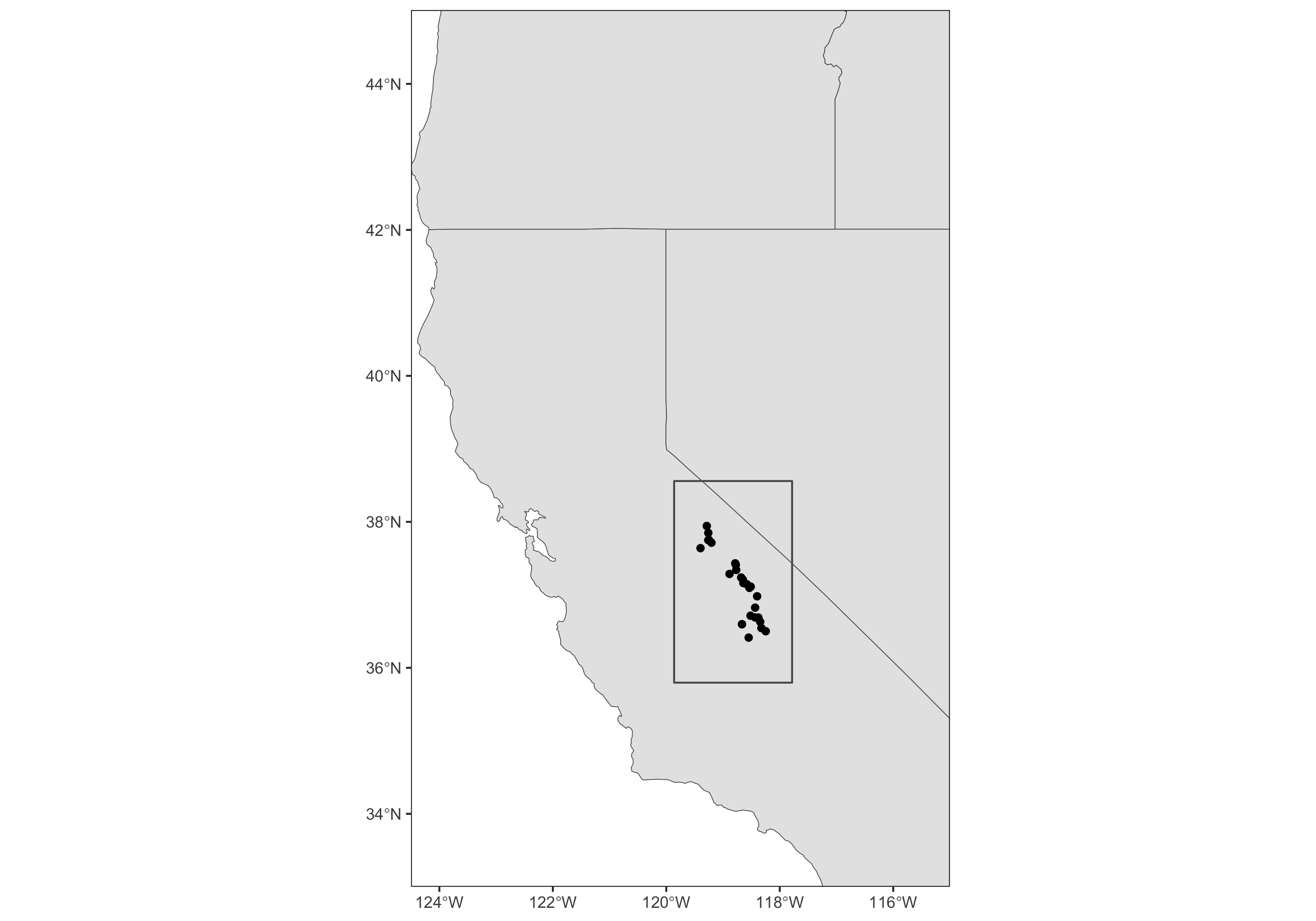
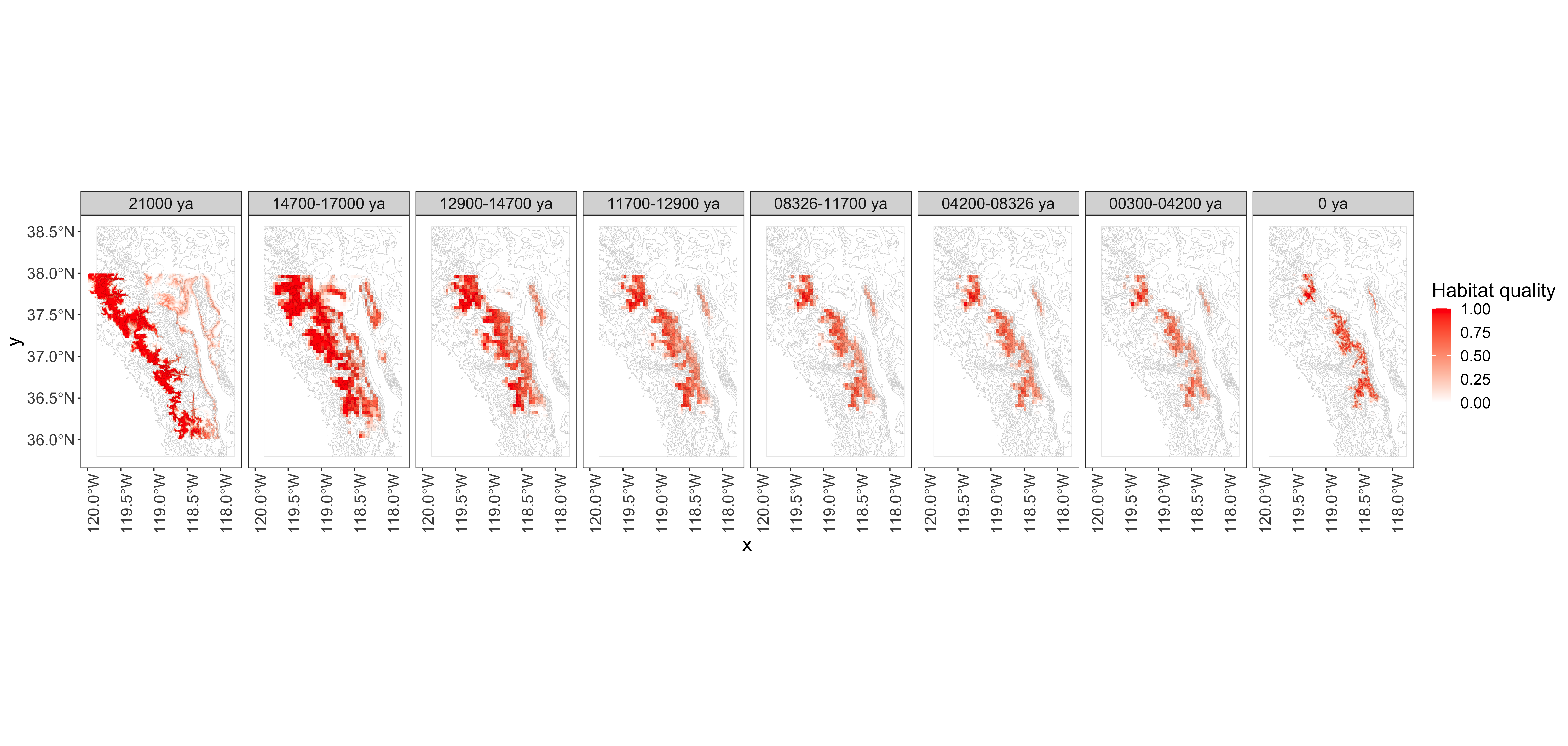
Methods overview
- Develop an individual-based SLiMulation.
SLiM screenshot
Methods overview
- Develop an individual-based SLiMulation.
- Use presence-absence estimates to narrow the range of parameter values based on 200 years of simulation.
SLiM screenshot
Methods overview
- Develop an spatial, individual-based SLiMulation.
- Do ABC on presence-absence estimates to narrow the range of parameter values based on 200 years of simulation.
- Run simulations since LGM, and do ABC on mean heterozygosity and divergence.
SLiM screenshot


